Trending
Opinion: How will Project 2025 impact game developers?
The Heritage Foundation's manifesto for the possible next administration could do great harm to many, including large portions of the game development community.

Featured Blog | This community-written post highlights the best of what the game industry has to offer. Read more like it on the Game Developer Blogs or learn how to Submit Your Own Blog Post
After 5 years designing game economies generating $150M+, I've compiled my knowledge into a detailed 7-chapter guide on game economy, balance, and monetization.
November 15, 2024

Hello, dear readers!
Wiserax is on the line. After working in game development for over 5 years—designing the economy and balance for projects that have generated over $150 million in revenue — I decided to disappear for the last six months to consolidate all my knowledge in game economy, balancing, and monetization into one work and share it with other developers.
There are very few materials in this field; as of writing this article in the fall of 2024, there are only about 20 scientific articles and a couple of books, one of which is an 800-page tome by Brenda Romero and Ian Schreiber. I have compiled all this information into one article and added my own knowledge and experience, so I believe that my insights will be useful to you.
By studying this detailed guide, you will learn how to successfully monetize games, develop strategies and balance for a sustainable economy, and become acquainted with current trends in the gaming industry.
We will start with the basics of game economics and gradually dive deeper and deeper until we understand how to create an economy that not only brings you income but also provides genuine enjoyment to players.
My article contains 7 chapters in total; the material has turned out to be quite extensive.
Happy reading! 😊
P.S. Dear readers, this article contains a lot of information on game monetization and how game developers can make money. I have come across many comments from readers who express discontent, saying, "Why should games make money? I don't like ads or in-app purchases; games should be free!"
So, if you are not ready to read about how games generate revenue from their players, please feel free to close this article.

The gaming market, despite the blow from the pandemic, continues to grow steadily. It is estimated that the global gaming market will reach $189.3 billion in 2024 and $197.1 billion by 2025 [1]. This is a good reason to take a closer look at how games generate revenue and how to monetize your game while meeting player needs.
My name is Alex Karpenko. Having worked in game development for over 5 years, designing the economy and balance for projects that generated more than $150M in revenue, I will share with developers how to create an economy for your project so that it thrives and earns. By studying this detailed guide, you will learn how to successfully monetize games, develop strategies and balance for a sustainable economy, and get acquainted with current trends in the gaming industry.
A well-designed economy can bring your game world to life, making it dynamic, engaging, and real. Players will feel like part of this world, and this sense of belonging will keep them coming back again and again.
Let’s dive together into the wonderful world of game economy and balance, break it down into its components, and understand how to create an economy that not only brings you income but also gives players true enjoyment.
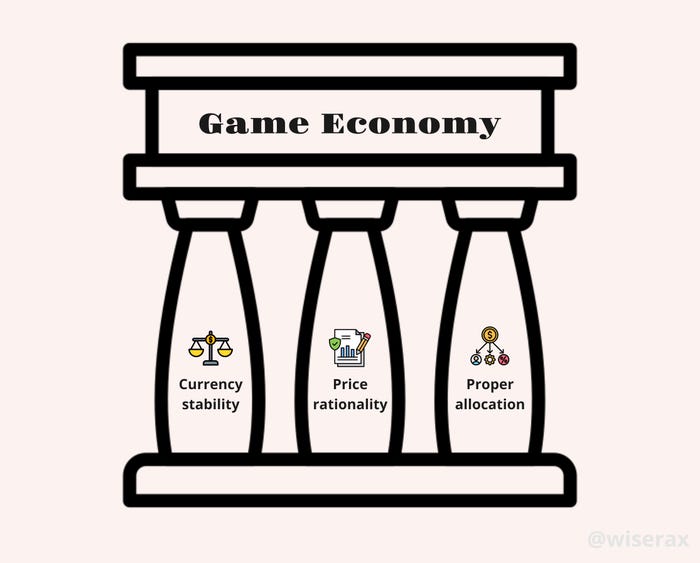
"We expect our dinner not from the benevolence of the butcher, the brewer, or the baker, but from their regard for their own interest." Adam Smith
Building a successful game economy is a multi-layered task that requires deep understanding and a thoughtful approach. Professor and PhD Edward Castronova argues that currency stability, price rationality, and proper resource distribution are the three pillars that will help you create a sustainable economy [2]. Let’s examine each of them in more detail.
To illustrate key principles of economic design, we will sometimes refer to "Budget Adventure"—a fictional game whose developers didn’t really care about the economy and just made things up randomly.
Your in-game currency is the lifeblood of the economic system. If the blood circulates irregularly, the body cannot function properly. The same thing happens with a game economy: unstable currency leads to chaos and player dissatisfaction.
For the currency to be stable, it must fulfill three main functions:
Medium of exchange — it should be used for transactions. Imagine a game where a player can easily propose: "I’ll give you 50 gold for that helmet." This is important because it allows players to trade goods without barriers, even if their items are not directly comparable in value (e.g., trading a horse for a staff).
Unit of account — the currency should allow for the valuation of goods and services. This simplifies the process of trade and makes meaningful discussions about the value of different items in the game possible. A player should be able to ask, "How much is my house worth in golden dragons?" A stable currency gives players and developers a clear understanding of how much each item is worth in the game world.
Store of value — players should be able to save currency with confidence that its value will be preserved. This allows them to set aside earned funds, making the game world more persistent and reliable. Players need to know that even if they take a break from the game, they will be able to use their savings when they return.
In "Budget Adventure," the currency fluctuates so wildly that players never know how much their loot is worth. One day a sword costs 100 gold, and the next day it’s 10,000. Player "PoorPlanner" decides to save 10,000 gold to buy a legendary sword. After many days of farming, he finally collects the required sum, but by the time of purchase, the sword’s price has soared to 500,000 gold. Now he’s running around with a carrot instead of a sword.
Take a real example: in Diablo 2, by the end of the game, gold had become so devalued that players stopped using it and switched to a more stable item — the Stone of Jordan. This item completely replaced gold as the main currency, and all game items were valued in quantities of Stone of Jordan. [2]
Without reliable currency, the game economy becomes chaotic, and players spend more time negotiating the value of goods than on the core gameplay, which can diminish the enjoyment of the game.
Rational pricing is the foundation of player trust in your economy. Prices should reflect the real value of items and adapt to changes in supply and demand. Armor should be expensive, and cabbage should be cheap.
However, sometimes the system can break down:
Prices may be too low, creating shortages due to high demand.
Or they may be too high, resulting in a surplus due to low demand.
It’s also crucial to monitor the balance between production and consumption. If rare items appear too frequently, their value drops. On the other hand, if a common item becomes scarce, its price can skyrocket.
Another thing the developers of "Budget Adventure" love to do is place merchants selling goods at fixed prices in infinite quantities. Such an action helps developers fix prices, but it removes players from trading in basic goods.
It’s important that the right items go to the right players. You don’t want a mage to get armor and a warrior to get a staff, with neither being able to use these items. This causes frustration.
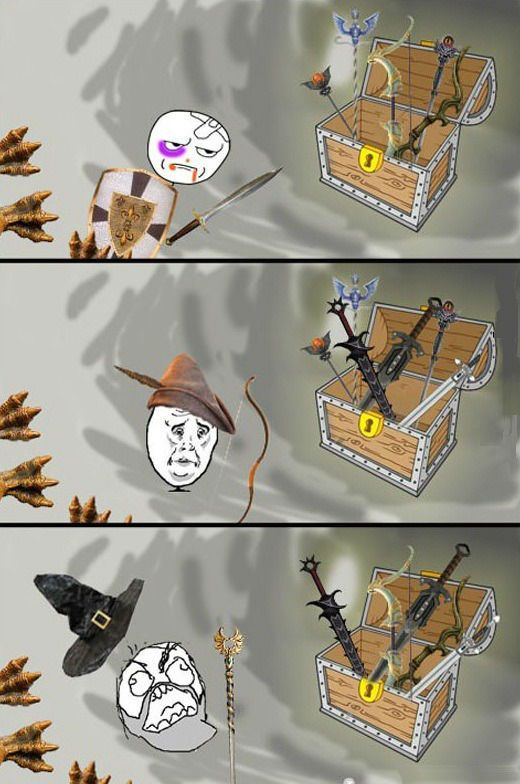
For some strange reason, players are always dissatisfied..
In addition, players should receive appropriate rewards for their efforts. If in your game a strong player receives the same rewards as a novice, this will lead to frustration and player churn. Proper reward distribution is a balance between effort and reward that keeps players engaged and motivated.
Principles of proper distribution:
All players start on equal footing.
Players who put in more effort receive greater rewards.
If you can balance all three aspects, you have a good chance of building an effective and sustainable game economy.
Now that we’ve covered the basic principles of economic design, let’s move on to the next important aspect — the flow of resources in the game. This involves understanding how resources move and are distributed among players and systems within the game. This determines how efficient and engaging the gameplay will be.
"The best moments usually occur when a person’s body or mind is stretched to its limits in a voluntary effort to accomplish something difficult and worthwhile."
Mihaly Csikszentmihalyi
The movement of resources within a game is a key aspect that influences balance and player engagement. The main concepts that help manage this process include creating emotional swings and properly distributing content over time.
But how do you distribute resources correctly to keep the player from getting bored and constantly in the flow state described by Csikszentmihalyi?
Creating emotional swings is one of the key elements of retaining players. But to understand how it works, let’s turn to the science of the brain—neurobiology.
Our brain, the result of millions of years of evolution, constantly seeks balance between stimulation and satisfaction. Two neurotransmitters play a central role in this process: dopamine and endorphins.
Dopamine is the "anticipation hormone" that motivates us to keep going in hopes of a reward. It is activated during moments of expectation, whether it's waiting for a new level, a rare item, or defeating a tough boss. In an evolutionary context, dopamine was crucial for survival. Imagine our ancestors: searching for food, avoiding predators—these activities required constant effort and activity. Dopamine in such situations "turned on" motivation and maintained interest in seeking rewards, even when they were just beyond the horizon.
Endorphins, on the other hand, are released when the reward is received, causing feelings of joy and satisfaction. It’s like an internal "prize" for achieving a goal. Endorphins also have a pain-relieving effect, which literally helps us "forget" the difficulties we faced on the way to success. In games, as in life, endorphins encourage us to return to what brings pleasure and fulfillment.
Now, understanding how these neurotransmitters work, it becomes clear why emotional swings are not just about playing with resources, but about the science of keeping the player in a constant state of seeking and satisfaction. It’s important not only to reward the player but also to skillfully create moments of anticipation, so dopamine drives them to new achievements, while endorphins reinforce success and the desire to continue.
Imagine a player named BeautyQueen278 stuck on level 189 of Candy Crush Saga. Every time BeautyQueen278 gets close to the final combination, but the candies don’t quite line up, her brain is literally bathed in dopamine: "Just one more try, I’m almost there!" It feels like victory is just around the corner. At this point, she’s ready to buy a booster... but here’s the interesting thing: this balance between frustration and anticipation is what keeps her playing. Finally, on the 11th attempt, BeautyQueen278 beats the level, and her brain is flooded with endorphins. She’s so happy she could soar like the candies on the screen. But you know what makes the difference here? BeautyQueen278 is not only given the victory but also a small gift—another life after so many attempts. This is the perfect balance: you’ve won, but they give you just enough resources to keep you playing without feeling totally drained.
Players should experience two or three different emotions in a single session. This helps maintain interest and motivation. If players experience frustration several times in a row, they may lose interest in the game. Properly managing emotions through resource distribution and level design is key to success.
Spreading content over time is another important aspect of maintaining player interest. At the beginning of the game, you should generously distribute content to grab players' attention and give them the chance to feel successful. In the first few sessions, players should receive rewards quickly and easily. This allows them to familiarize themselves with the game’s resources and become accustomed to them.
Imagine a puzzle game where the player has just started. On the first day, they face an incredibly difficult level and, despite their best efforts, cannot pass it. Instead of giving the player a chance to progress quickly early on, the developers decided that a level with unbeatable puzzles was a great idea. Player "PuzzleNoob" spends an entire day trying to beat the first level and ultimately decides it’s easier to delete the game than waste their nerves.
As progress is made, the pace should slow down, requiring players to put in more effort to earn rewards. This helps create a sense of scarcity, encouraging players to invest more into the game. For example, if players begin to struggle with passing levels, they may turn to boosters or other paid upgrades if it fits within the game’s monetization strategy.
Now, let's move on to the key concepts of resource distribution—spend points and sources [3].
It’s like managing finances in your personal banking app. Sources—where the player earns resources. In a game, these can include:
Mission rewards
Short-term events
Loot (trophies, drops)
Achievements
Passive income
Seasonal rewards and battle passes
Social interactions
Gameplay mechanics
Watching ads, and more
On the other hand, spend points are where the currency earned from sources is drained. We will explore spend points and sources in more detail in chapters 4 and 5.
Too many resources from sources—and the balance overflows, leading to inflation. Too few—and players lose interest. Balancing between sources and spend points is the key to a stable game economy.
In Clash of Clans, developed by Supercell, resources come from mines and collectors (sources), and are spent on building and upgrading (spend points).
In EVE Online, resources come from mining, production, and trade (sources), and are spent on shipbuilding, purchasing modules, and participating in wars (spend points).
In World of Warcraft, players earn resources through quests and raids (sources), and spend them on crafting items and upgrading gear (spend points).
The developers of these games carefully monitor the balance of resources to maintain player interest.
Now that you know what sources and spend points your player has, you can build a Resource Flowchart (which can be done even in the early stages of game development).
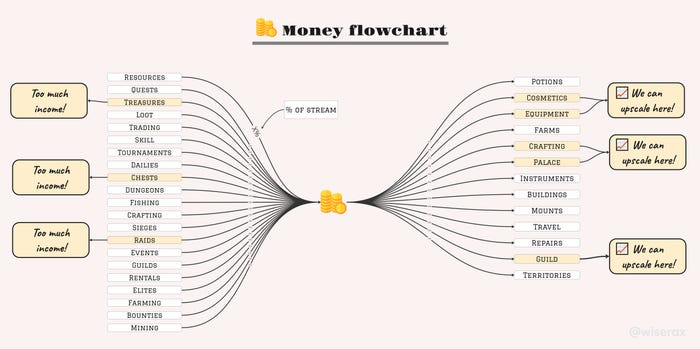
Caption: When designing the resource flow in your game, it’s crucial to account for even the smallest spend and income sources so that developers can see the full picture.
As a developer, you’ve set up analytical events on all the key mechanics of your game, and you have access to the product’s analytics—you know how much of a resource, like money, the player received from the "Loot" or "Quests" categories. By calculating the percentage of total flow using the Resource Flow Chart, you can easily see where in your game there are areas for improvement, where you’re oversupplying, and where you’re asking too little.
You can create a similar flowchart for all of your game’s mechanics, linking them into a single ecosystem to understand how introducing a new mechanic will impact the economy of your project. Tools like Machinations.io, Miro, or classic GS/Excel tables can be used to build such flowcharts.
During the development of the game "Dreamdale", we noticed that players quickly accumulated the main currency by exchanging resources for money but spent almost none of it. An analysis of the resource flow chart showed that the spend points were not attractive enough. We added new upgrades and special events requiring resource expenditures, and the game’s economy became more balanced.
Questions to Consider:
What sources and spend points are present in my game?
What incentives are my players experiencing right now? Are they enough?
Am I "playing" with the player, making them feel scarcity at times and abundance at others? Or do they always have enough of everything?
Now that we’ve covered resource flows in the game, I suggest we delve deeper into the player, for whom we are striving. Using examples from scientific research, we will try to better understand the nature of the people who play our games and attempt to answer the question:
Can we reliably know if the player will actually enjoy playing in the updated balance?
"Man is a mystery. It needs to be unraveled, and if you spend your whole life unraveling it, don’t say you’ve wasted time." Fyodor Dostoevsky
Entertaining the human brain is incredibly challenging, as it is one of the most mysterious and complex objects in the universe. What’s worse, most of its work is done secretly from our consciousness. Think about it: when was the last time you consciously controlled your body position or breathing rate? As you read this text, you probably aren’t aware of how your eyes are moving across the lines. Are they moving smoothly or making tiny jumps? You’ve been reading books all your life, but perhaps you’ve never thought about how this process works. Similarly, when you speak, you don’t always realize what you’re about to say until the words leave your lips. Who’s doing all these subconscious calculations?
Here’s another example: you’ve probably driven along a winding road hundreds of times, turning the steering wheel at just the right angle. Can you even recall how you tracked the curves of the road? Strangely enough, after reading the phrase "imagine eating a burger with pickles," your mouth suddenly fills with saliva. Why? Who gave the command?
Here’s one of Jesse Schell’s favorite examples from his bestseller The Art of Game Design. Call your friend and ask them to do these three things:
Say the word "post" five times in a row: “Post, post, post, post, post.”
Now pronounce it clearly and loudly so it sticks in your head: “P-O-S-T!”
Answer this question: “What do we put in a toaster?”
If your friend answered "toast," congratulations! You’ve caught them in a subconscious trap because the correct answer, of course, is "bread." By repeating the word "post" too often, the brain cleverly associates it with something similar—and there you have "toast"! This is a classic example of how certain stimuli can alter our expectations and decisions.
Unlike a book or movie, where the hero’s path is predetermined, in a game, every player is free to choose their own path. And this makes the game designer’s task both challenging and fascinating. We can only guess how the player will play our game.
I recall as a child playing Serious Sam, I would run in the complete opposite direction from the temple with monsters at the start of a mission, just to see where the edge of the map was. The greater the degree of freedom in a game, the more responsibility the developers take on.
Since the topic of player psychology remains underexplored, I reviewed all available studies as of summer 2024 relevant to game economics. In this chapter, I will reference scientific research to enhance the credibility of the information presented and minimize subjective interpretations.
A study conducted by Dardis et al. (2019) found that game difficulty can provoke negative emotional reactions in players, which, in turn, reduces the effectiveness of advertising [4]. In hardcore games, advertising is less effective.
As a result, we can speculate why the advertising monetization format has succeeded primarily in casual games, while in competitive games, only IAP (in-app purchases) dominates. Imagine the frustration caused by forced ads during an intense battle with an opposing team.
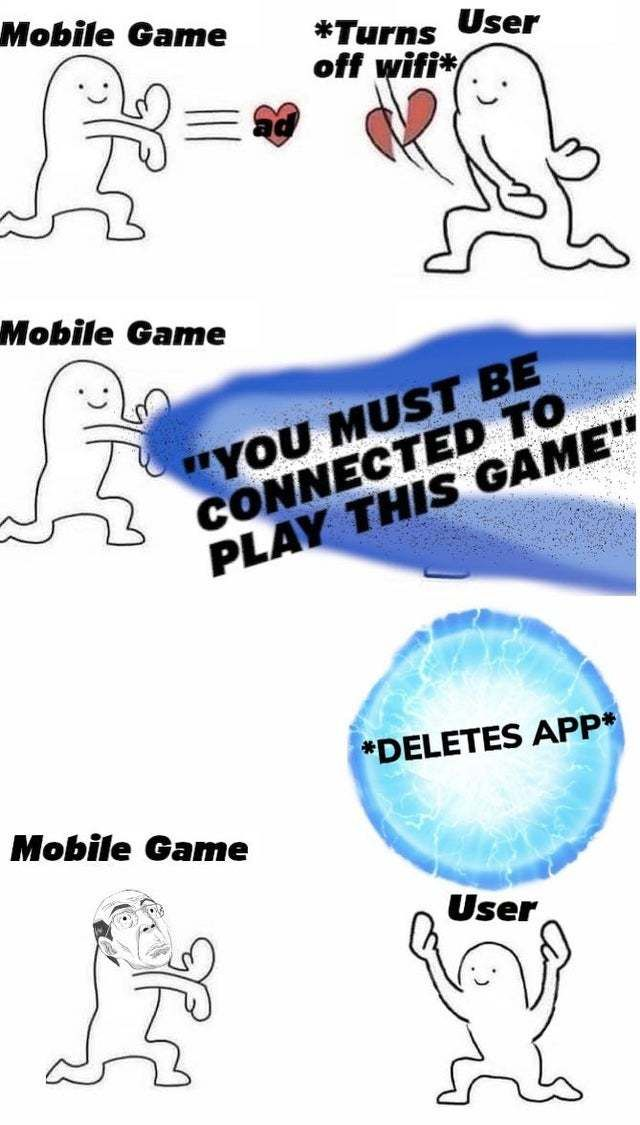
In "Budget Adventure," ads appear at the most inappropriate moments. The hero "Tommy-Tapper" is fighting a dragon, his health is almost depleted, and suddenly a toothpaste ad pops up. Tommy loses the battle, and the player decides it’s time to delete the game and switch to a more considerate developer.
Another study on ad-based monetization, conducted by Lee & Shin (2017), analyzed data from a mobile app in Korea, collecting 1,404,295 transaction records from September 2013 to May 2014.
Providing users with free in-game items can create a trial effect and increase the likelihood of users making in-app purchases. Analyzing user behavior data within the app, the researchers found that users who were offered a free in-game item as a reward were more likely to make a purchase [5].
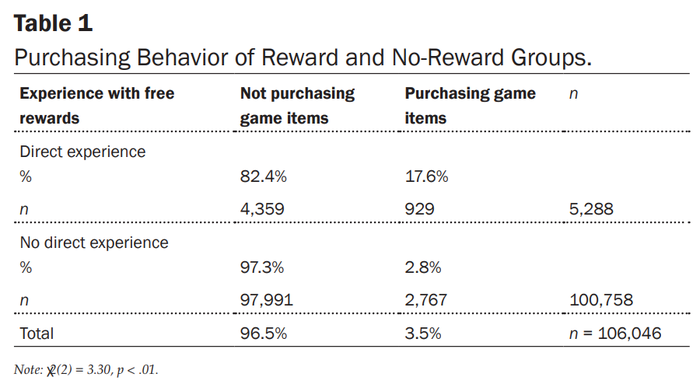
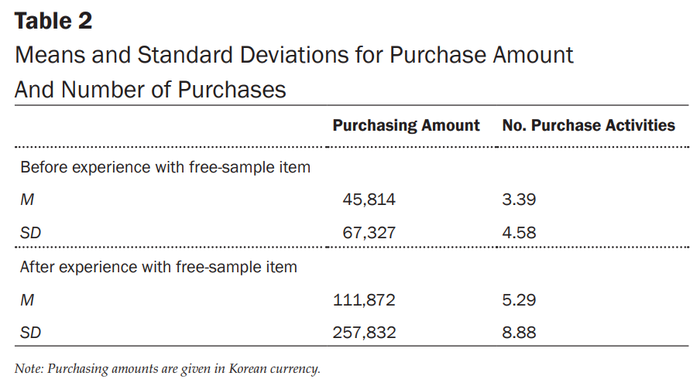
Providing players with trial items increased the number of purchases
Research has shown that game achievements, in-game item purchases, and social interaction positively influence playtime and in-game purchases (Jiao et al., 2022) [6]. This study was based on an analysis of weekly activity and spending data from 100,000 players in a free-to-play (FTP) mobile game over a three-year period.
These factors can be used by developers to retain players and increase their spending in the game.

Game Achievements: An inverted U-shaped effect shows that players who perform either very well or very poorly in a game during one week tend to play less and make fewer purchases the following week. Developers should monitor player performance and offer rewards to prevent player churn.
In-game Item Purchases: Players who purchase in-game items tend to play longer and make more purchases the following week. Developers should create personalized virtual items with individualized pricing to encourage prolonged play and increased spending.
Social Interaction: Players who are members of clans or play with friends tend to play longer and make more purchases the following week. Developers can encourage players to invite their friends to play together to increase engagement and revenue.
As an experienced developer, you already understand how crucial it is to grasp player psychology in order to create a successful game. Imagine your game not only engaging players but also motivating them to return again and again through a deep understanding of psychological aspects. These insights are available to any developer, regardless of team size or budget. The key is to apply them wisely and adapt them to the specifics of your game. Studying player psychology is no easy task, but the time invested will pay off in the form of a loyal audience and steady revenue.
The path to perfection lies in constant study and data analysis, allowing us to better understand players and adjust our approach to meet their needs. Step by step, we can strive to create games that not only bring joy to players but also provide us, as developers, with the revenue needed to support our teams and create even more ambitious, better projects.
Questions for Reflection:
Does my game have elements that can surprise the player? How can I add unexpected surprises or rewards?
Am I offering my players trial items to increase the likelihood of a purchase?
What emotions do I want players to experience when interacting with my game’s economy? Why?
Now that we’ve gained a better understanding of the nature of people playing our games, let’s move on to the next central topic of this article—creating and balancing the game economy.
"Our current situation resembles that of ancient alchemists. Before Mendeleev invented the periodic table of chemical elements, visually demonstrating the relationships between basic elements, alchemists used primitive rules to define these connections that they developed through trial and error. These rules were incomplete, sometimes incorrect, and often unscientific, yet using them, alchemists created amazing things, and their search for truth led us to what we now consider modern chemistry."
Jesse Schell
Welcome to the lab! We've arrived at one of the key sections of this article.
If you start searching online right now for specific examples of game balance, templates, and formulas, you’ll be surprised because the best you’ll find are fan-made tables of constants and guides on mechanics. There are two main reasons for this:
Companies carefully protect their intellectual property, and balance tables of companies like Supercell, Blizzard, Riot Games, Gameloft, and others are hidden in their internal bureaucracy and protected by NDAs.
No standard, universal approach exists for balancing games. Some games have balance embedded directly in the custom engine's configs, others use Excel or Google Spreadsheets, another might use Machinations.io, and yet another has paper-based calculations. As many ways as there are to develop, there are just as many to balance.
In this chapter, I will attempt not only to go beyond standard recommendations but also to give you a universal tool for balancing your game.
When I started working on this chapter, I spent a long time thinking about how to approach game balance. After all, it is an incredibly deep and multifaceted topic. Game balance isn’t just a set of numbers to put into a table. It encompasses player experiences, interactions of game elements, engagement, rewards, and, of course, the overall experience.
The last book I read on game balance, Game Balance by Ian Schreiber and Brenda Romero, was 800 pages long [10]. Covering everything in one chapter is practically impossible.
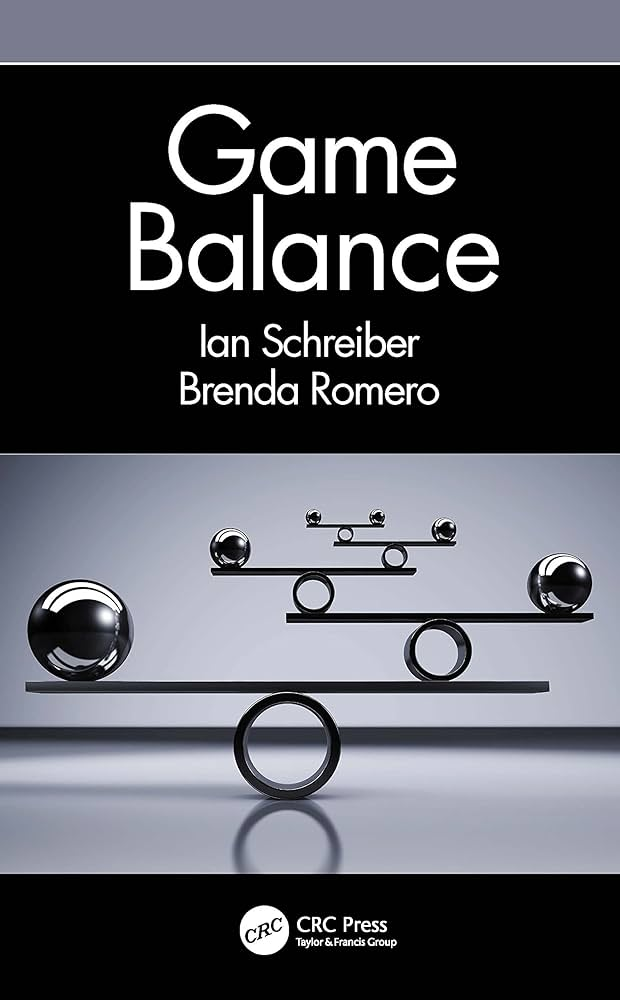
And to be honest, even with my years of experience in game balance and economy, I struggled with where to start. Therefore, I decided to take a creative approach—in this chapter, there will be three sections that, if applied, will help you manage any game economy and balance challenge:
Basics: Useful tips for balancing any project, regardless of genre or platform.
Practice. Old School—Spreadsheets: We'll discuss how balancing tasks have traditionally been handled with spreadsheets and how they can help you organize processes in your project.
Practice. New Approach—A Universal Tool: The latest development in the world of game balance, significantly simplifying work on any type of task.
Let's consider an example from my previous research on game balance in 2022. [9]
Imagine a new card is added to a strategic card game. The game’s main resource is called "Mana." Even the weakest effects cost at least 1 Mana to use.
Here’s the card:
"Get Lost You All" - Cost: 0 Mana.
Action: You win the game.This card breaks the game for obvious reasons. In most strategy games, the joy comes from interactive gameplay and meaningful choices. This card destroys all of that. When someone draws "Get Lost You All," they have no interesting decision about which card to play—it’s always the winning choice. Just draw it and win.
With this card in the game, deck-building ceases to matter. Moreover, the only likely competitive strategy would become playing as many cards as possible to increase the chance of drawing "Get Lost" before the opponent.
Let’s look at another example.
Consider this math problem and select the correct answer below:
Problem: 2x + 4x - 4 = 0 <ol><code>
<li>x = -1 +/- √3</li>
<li>x = -1 +/- √3</li>
</code><li><code>x = -1 +/- √3</code></li></ol>The problem might be interesting, but the choices are all the same. It’s a multiple-choice question where your choice doesn’t matter.
This is what happens when all cards and strategies in a game have equal strength. Every card you decide to include in your deck, every strategy you choose, is a choice. If all choices are equal, the choice, ultimately, doesn’t matter.
Earlier, I provided two opposing examples: in one, player choices determined everything, while in the other — nothing. There’s no balance here, and as a result, the game turns either into a chaotic ride or a dull déjà vu. To create an engaging experience, it's important to understand that balance isn’t about perfect power distribution but about finding that “golden mean.”
Game Вesigner Mila Pilipenko notes, “Balance is a process, not a final result.” I completely agree with this thought, because during development, everything can change, from the storyline to the core mechanics (and, honestly, that’s something no one wishes for).
Balance is a process, not a final result.
Now that we understand balance is not static equilibrium but a living mechanism, let’s move on. It’s time to define the game’s core values. Without a clear understanding of these values, attempts to balance the game are like putting together a puzzle blindfolded – with almost no chance of success.
The first step in creating balance is identifying the game’s core values. From classic value theory and common sense, we know that time is the primary resource for everyone. Your task is to translate all in-game values into units of time.
Example: Imagine a game where players need to complete 300 levels. If an average player completes 10 levels a day, we can assume that the entire game will take about a month to finish. Thus, every value in the game should be expressed in terms of the time required to achieve it. This not only helps balance the game but also makes it more predictable for analysis.
As a developer, knowing the time equivalent for each of your mechanics and resources gives you a powerful tool. For example, if a player wants to reach the top of the leaderboard, you know it will take them about a month of playtime, as well as how much content they’ll need to go through.
To simplify, calculations are done for an idealized player who performs each action with maximum efficiency.
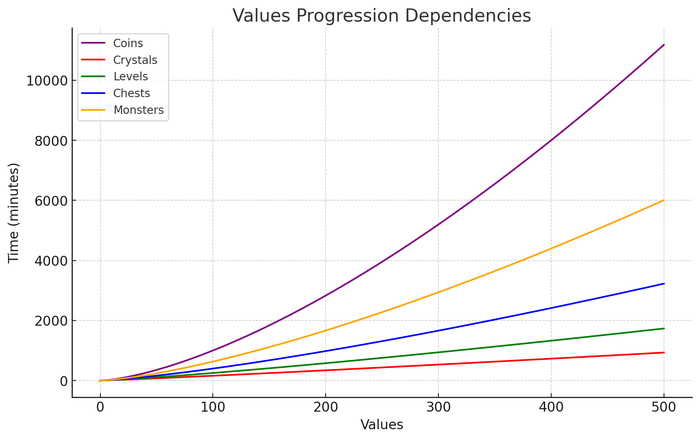
To maintain player interest, the game's difficulty function should resemble the classic Difficulty Curve, which grows either linearly or exponentially.
Critical resources directly influence the speed at which the player achieves the main game objective. These resources should be measured in time and carefully managed to avoid imbalances.
Example: In a building game, resources like gold or wood may be critical because they speed up construction and content consumption. Their availability should be limited to prevent players from progressing too quickly without additional investments.
Non-critical resources are those that do not directly affect player progress but can enhance the gaming experience. Examples include cosmetic items or decorative elements.
Now that we have identified the core values and resources, it’s time to establish a cost system and ensure currency stability from Chapter 1. Here, it’s important to create dependencies between game values and currency so players can reasonably assess the value of their efforts.
If a sword in the game costs 1,000 gold coins and an average player earns 100 coins per hour, they would need to play for 10 hours to buy the sword. This approach helps set realistic goals and maintain player interest.
The final output could be a chart showing how players progress through the game’s content, the time required to overcome it, and the necessary game elements.
Break down your game into stages and group them by difficulty.
Use paywalls—situations where the player can proceed to the next level but must make an effort or spend significant time to do so. This motivates the player to invest more in the game, perhaps by using in-game currency or watching ads to speed up the process in a mobile game.
In mobile gaming, around 60% of revenue typically comes from such missions. In games I’ve worked on, I’ve seen players spend thousands of dollars to clear paywalls. It’s essential to provide the option for players who want to make these purchases if it fits your monetization strategy.

The difficulty of missions increases over time. Peak challenges are followed by a decline, and then another rise.
Naturally, this is always a double-edged sword: you cannot create a paywall that most regular non-paying players can’t overcome, or you’ll lose future payers and loyal fans.
Higher mission difficulty → Players spend more, but it’s also true that
higher mission difficulty → More players quit and uninstall the game.
Some game economy designers say that no more than 4% of players should quit due to mission difficulty; I aim for this number when designing mission difficulty in mobile projects. Ideally, the dropout rate should be close to 0%.
Track your players' progress and carefully test the balance you apply in your game to avoid excessive frustration.
Start with reasonable timeframes:
First-time user experience should be calculated minute-by-minute
The first day should be broken down by the hour, etc.
The Difficulty Curve is essential in this context as it directly ties into your game's stages. In our world, matching this curve in games is a necessity, not a whim.
Below is a chart of balance zones based on player skill and game difficulty. As players' skills increase, difficulty should also increase to maintain balance.
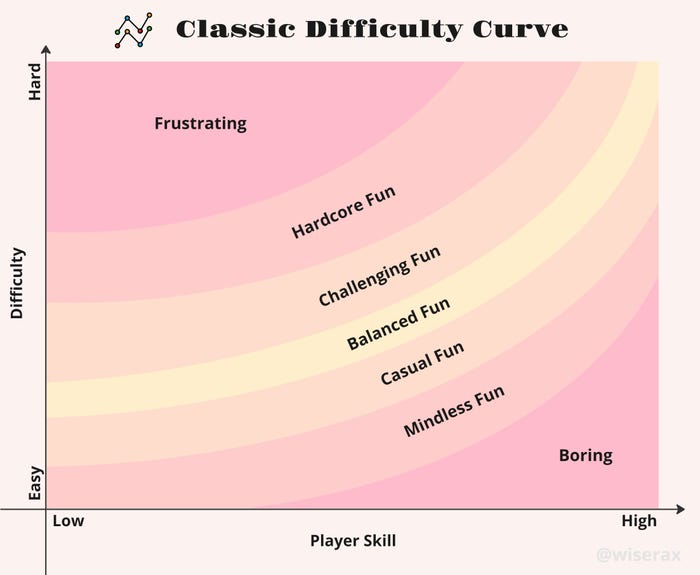
The balance zones are as follows:
Frustration – too difficult to be enjoyable
Hardcore Fun – very challenging, but some people enjoy it
Challenging Fun – for those who love overcoming difficulties
Balanced Fun – the Goldilocks zone (not too hard, not too easy)
Casual Fun – beautiful and easy, never a challenge but not meaningless either
Mindless Fun – players just want to play; they don’t want to think
Boring – I could play this in my sleep... but actually, I’d prefer to sleep
If you’ve calculated that your game content will provide enough gameplay for six months of active playtime, make sure the resources players can acquire in that time will allow them to reach the projected point—not too much, so they end up in the boring zone, and not too little, so they end up in the frustration zone.
Use the difficulty curve as a checkpoint for your graphs and calculations.
Your task is not simply to enter numbers into a spreadsheet but also to understand how they interact with each other. Problems of mathematical balance are solved through combinatorics, probability theory, mathematical statistics, and game theory. [10–13]
Simulating Game Economy: Create a model of the interaction between various game elements (resources, currency, NPCs) and run a simulation to see how they influence each other. For instance, if NPCs collect resources that players can trade, make sure the economy is closed, and resources don’t appear out of thin air.
Automated Balancing: Use automatic testing and balancing tools to model and simulate the project’s economy, automatically adjusting parameters under specified conditions. We’ll return to this in the third part of this chapter.
Spreadsheets are our trusty tool in the battle for balance, and if you haven’t come to love them yet, now is the time. They never betray you, unlike the latest automation services and calculation tools. Spreadsheets are like an old friend—perhaps not the most exciting but always there to lend a hand.
But as with any tool, it’s important to know how to use it correctly. Let’s dive into how to get the most out of this tried-and-true approach.
Grouping and Color Coding
The first thing I do when I start working on calculations is organize the data. It’s critical to first extract all constants, then bring out variables, and only afterward calculate final metrics and results.
Grouping: Think of it as organizing a room. Everything related to weapons should be in one place. All level information should be in another. Grouping data in tables works the same way—it helps you keep order and makes the tables more understandable.
Color Coding: Your tables should be clear at a glance. I use green for constants entered manually (e.g., base weapon damage), blue for variables calculated automatically, and purple for final values. It’s like placing everything on shelves, so you know exactly where each item is.
Like anyone who enjoys their work, I sometimes go beyond the standards. Occasionally, I like to add a bit of colors — who says spreadsheets can’t be fun? When I work on thematic events, like Valentine’s Day, I’ll even color code calculations according to themed palettes from sites like Color Hunt or other color palette websites.
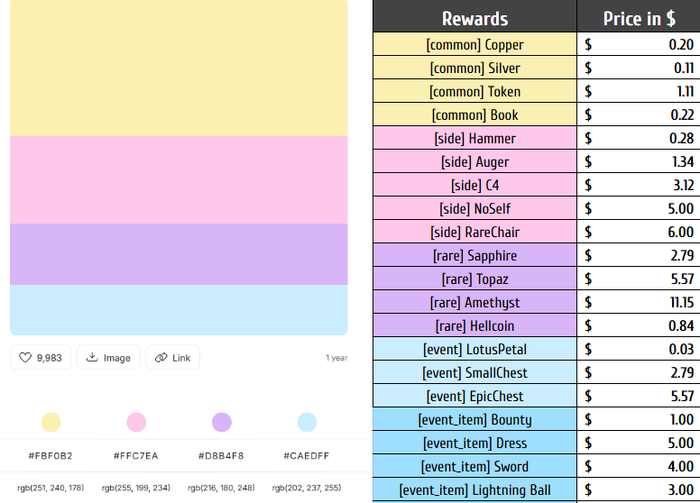
Automation helps prevent mistakes and saves time. Here are a few tools worth using:
Data Validation: Allows you to restrict data input in a table to acceptable values only. For example, if you have a column with difficulty levels, you can set it to accept only certain values (e.g., “Easy,” “Medium,” “Hard”). Choosing from a dropdown saves time and keeps data consistent.
!img13.png
Pivot Tables: Pivot tables allow you to aggregate and analyze data, helping you spot overall trends and patterns. This is especially helpful for analyzing large data sets.
Using Templates: Creating templates for frequently performed tasks speeds up work and reduces the chance of errors. I have templates for everything from small idle game calculations to complex LiveOps events. Over time, you’ll accumulate a library of templates, making you an invaluable specialist.
Regular Data Updates: Ensure that data in your tables is up-to-date. Use automatic updates when possible, and check regularly to avoid working with outdated data.
Charts and Graphs: Using charts makes data more accessible and easier to understand, especially for those who don’t want to sift through long columns of numbers. Charts help you see dynamics and trends, especially if you’re presenting to your supervisor.
Documenting Formulas and Processes: You never know when you’ll need to revisit a spreadsheet—maybe in a few weeks, maybe after a late night out. Add comments to your formulas so you can understand what that “spell” meant in a month:
=IF(ROUNDDOWN(S$4$J$5^($Q8-1)+($Q8-1)$I$5,-1)>$K$5,$K$5,ROUNDDOWN($S$4$J$5^($Q8-1)+($Q8-1)$I$5,-1)) What’s the formula above? Hard to say right away, isn’t it? Believe me, your future self will thank you.
Avoid Hard-Coded Values: Avoid using hard-coded values in formulas. You likely won’t remember what “0.2234” means in six months. Instead, use named ranges or variables to make the formula easier to understand and edit.
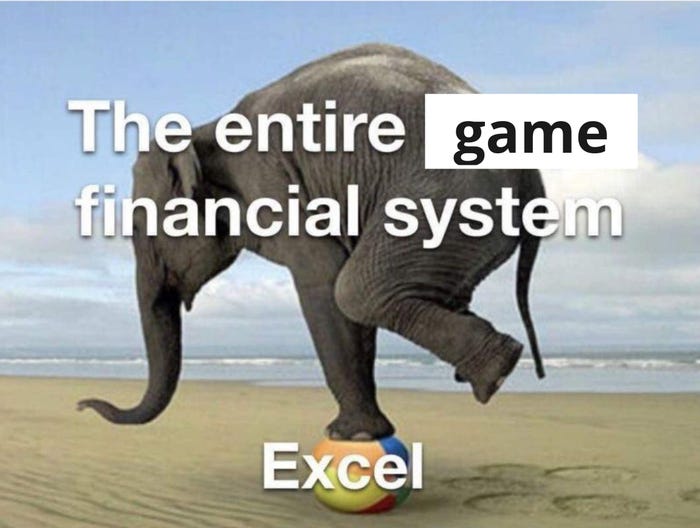
Spreadsheets come with numerous functions that simplify data work. Let’s look at my top three favorites, with specific examples from game development.
VLOOKUP: Resource Lists and Bundle Cost Calculation
Suppose you need to calculate the cost of an offer (in-game purchase of items). A poor approach would be to manually find each item’s price and then add them up, hoping you don’t make any mistakes. The issue with this method is obvious: once the data changes (and it will), you’ll have to redo everything.
A better approach would be to use VLOOKUP for automation. With this function, you can easily find the price of each item and add them up:
=VLOOKUP(A2, ResourcesTable!A:B, 2, FALSE)This formula searches for the item in a table and returns its cost. Then, just sum the prices of all items in the bundle, and the table does the work for you.
SUMPRODUCT: Complex Calculations with Multiple Data Arrays
Imagine you have a table with upgrade levels, their costs, and efficiency gains. A poor example would be attempting to calculate the total effect manually by multiplying and summing values in each row and hoping you remember to update everything when the data changes.
Usually, it looks something like this:
=E7E$2+F7F$2+G7G$2+H7H$2+I7I$2+J7J$2+K7K$2+L7L$2+M7M$2+N7N$2+O7O$2+P7P$2+Q7Q$2+R7R$2+S7S$2+T7T$2+U7U$2+V7V$2+W7W$2+X7X$2+Y7Y$2+Z7Z$2+AA7AA$2+AB7AB$2+AC7AC$2+AD7AD$2+AE7AE$2+AF7AF$2+AG7AG$2+AH7AH$2+AJ7AJ$2+AK7AK$2+AL7AL$2+AM7AM$2+AN7AN$2+AO7AO$2+AP7AP$2+AQ7AQ$2+AR7AR$2+AS7AS$2+AT7AT$2+AU7AU$2+AV7AV$2+AW7AW$2+AX7AX$2+AY7AY$2+AZ7AZ$2+BA7BA$2+BB$5BB$2+BC7BC$2+BD7BD$2+BE7BE$2+BF7BF$2+BG7BG$2+BH7BH$2+BI7BI$2+BJ7BJ$2+BK7BK$2+BL7BL$2+BM7BM$2+BN7BN$2And this is no joke—this was an actual formula in a commercial project used by the previous game designer before me on a fairly large, serious project with millions of users.
A better example is to use SUMPRODUCT, which does all this automatically:
=SUMPRODUCT(AA36:EM36,AA$3:EM$3)This function multiplies values from two data arrays (cost and efficiency) and sums them, giving you the result in one step. Everything updates automatically as you change the base data.
QUERY: Filtering Out Unnecessary Values from a List
Sometimes, data builds up in a table, and you only want to extract what’s important. A poor example is manually scrolling through the list to find and delete unnecessary rows.
A better solution is to use the QUERY function, which does this for you:
=QUERY(ItemsTable!A:C, "SELECT A, B WHERE C = 'Weapon'")```
This formula allows you to select only rows that match the specified criterion (e.g., only weapons) and remove everything else.
QUERY is one of the most complex and versatile functions, almost like working with databases.
If you’re unfamiliar with using complex functions like QUERY, especially for writing specific requests, the process can seem overwhelming—particularly if you’re in a time crunch.
In this case, my new assistant comes into play—Game Balance Guru.
Meet Game Balance Guru, a bot I created specifically for those who want to streamline work on game balance and economy. After a year of continuous improvement and expertise-building, it is now available to everyone, leveraging the latest OpenAI updates to help accelerate complex balancing tasks. And it’s free.
Game Balance Guru is your personal assistant ready to tackle any challenge related to game balancing, economy, or monetization. It’s important to remember that while Game Balance Guru is a powerful tool, it works best in tandem with you as a designer. It’s not a replacement for expertise or intuition but rather a way to significantly reduce routine work and speed up decision-making.
Game Process and Economy Analysis and Balancing:
Feature and Mechanic Balancing:
In-Game Resource Pricing Calculations:
LiveOps Event Reports and Recommendations:
Player Behavior Prediction Using Statistical Models:
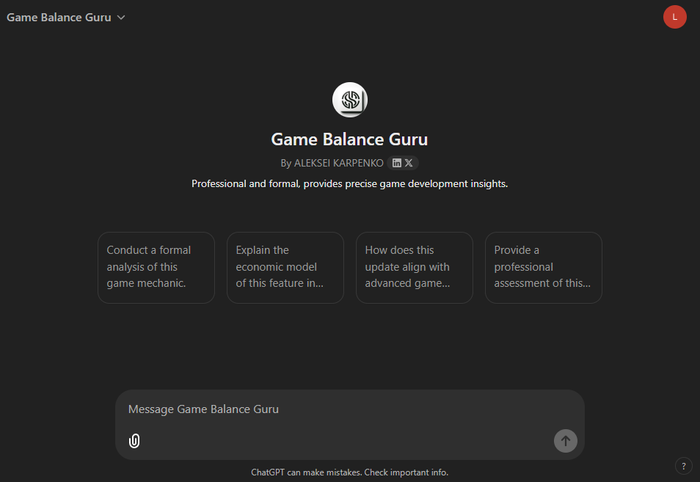
Bot's User Interface
To get started with the bot, simply follow this link:
https://chatgpt.com/g/g-M5YWlXD0B-game-balance-guru
No special knowledge or skills are needed to start—the bot will guide you through the process by asking for context about your game. The more information you provide, the better it will understand your needs and produce quality results.
Getting the Most Out of Game Balance Guru:
Copy Tasks from Asana or Other Task Managers: You can copy a task directly and paste it into the bot’s chat window. Just make sure it includes basic task details or requirements.
Add Custom Instructions: If there are specific requirements or nuances the bot should consider, include them. This will help it provide tailored recommendations.
Review the Results: Remember, Game Balance Guru is an assistant, not a replacement. While its suggestions are helpful, they should still be reviewed and fine-tuned by you.
Creating a Dedicated Version for Your Project:
If needed, you can create a customized version of Game Balance Guru for your project. This version can include data on prices, missions, and other game parameters to enhance task accuracy. For setting up such a custom version, contact me on Telegram (tg: @wiserax) or via email — contact details are available in my profile header.
Now it’s time to try your hand at balancing! The exercises below will help you apply the methods and calculations discussed to achieve an optimal balance in various scenarios.
Tower Defense games are classics when it comes to resource and damage balancing. Your goal is to build towers that automatically attack creeps (enemies) moving toward their goal in a way that maximizes DPS efficiency (damage per second) per unit cost. [10]
Swarm Tower
Only deals damage to flying enemies.
DPS (damage per second): 480
Cost: 640 units
Boost Tower
Doesn’t deal damage itself but increases the DPS of all nearby towers by 50%.
Cost: 500 units.
Configure the towers on a 4x3 field to minimize costs and maximize the overall DPS/Cost ratio. Here’s how to approach this task:
Calculate the DPS increase for each Swarm Tower based on the number of surrounding Boost Towers. For example, if a Swarm Tower is surrounded by four Boost Towers, its DPS will be: DPS = 480 (1 + 0.5 4) = 1440
Determine the total DPS value for all towers in the configuration: Total DPS = sum of all DPS values of towers, including the effect of Boost Towers
Divide the total DPS by the total cost of all towers in the configuration to evaluate efficiency: DPS/cost = Total DPS / Total tower cost
Compare multiple configurations to find the optimal DPS-to-cost ratio.
Compare different configurations to find the optimal DPS-to-cost ratio.
Additional Questions:
How would balance change if Boost Towers became more expensive?
Can you find a configuration that yields the highest DPS per unit cost?
In DOOM, players choose weapons depending on the situation. In this example, we’ll examine different weapon types and determine their effectiveness based on damage and ammunition usage. [10]
Fists: Deals 2–20 damage per hit at a rate of 123.5 hits/min, expected DPS = 22.64. Unlimited use, but melee range only. With the Berserk Powerup, damage increases up to 10 times.
Chainsaw: Deals 2–20 damage per hit at a rate of 525 hits/min, expected DPS = 96.25. Requires no ammunition but is limited to close range.
Pistol: Deals 5–15 damage per shot at a rate of 150 shots/min, expected DPS = 25. Uses bullets (up to 200 rounds in reserve). DPS = (5 + 15) / 2 150 / 60 = 25.
Chaingun: Deals 5–15 damage per shot at a rate of 525 shots/min, expected DPS = 87.5. Uses the same bullets as the pistol but consumes them quickly (entire ammo supply in 23 seconds). DPS = (5 + 15) / 2 525 / 60 = 87.5.
Shotgun: Fires 7 spread pellets, each dealing 5–15 damage. If all pellets hit, that’s 35–105 damage per shot. Fire rate is 56.8 shots/min, expected DPS with all pellets hitting = 66.27.
Rocket Launcher: Deals 20–160 damage from a direct hit plus up to 128 additional splash damage. Maximum damage per shot = 288, with a fire rate of 105 shots/min, DPS with consistent hits = 287. DPS = (20 + 160 + 128) / 2 105 / 60 = 287.
Plasma Gun: Deals 5–40 damage per shot at a rate of 700 shots/min, expected DPS = 262.5. Uses energy cells (up to 300 in reserve). DPS = (5 + 40) / 2 700 / 60 = 262.5.
BFG 9000: Deals 100–800 direct hit damage plus 40 additional rays at 49–87 damage each. If all rays hit, total DPS reaches 2773.75, but 40 energy cells are consumed per shot. DPS = (100 + 800) / 2 + 40 * (49 + 87) / 2 = 2773.75.
Calculate effective DPS for each weapon, factoring in ammo limitations. For example, the Plasma Gun with a full ammo load (300 cells) can fire for:
Identify the most economical weapon when ammo is limited and determine which weapons are best for specific situations.
Remove one weapon, such as the Chaingun, and assess how overall strategy shifts. Which weapons will take its place?
In this chapter, we explored how to create and maintain game balance effectively. We discussed the importance of defining core values, properly managing resources, and organizing game stages. We also emphasized spreadsheets as an indispensable tool for balancing and automating processes.
In addition, we introduced Game Balance Guru — a bot designed to accelerate and simplify game balancing and economic analysis tasks.
Questions for Further Consideration:
If your economy were designed not for players but for you as a developer, what would the most profitable balance look like?
What amount of in-game progress can be considered ideal in a single play session? How would this change if players had access to extra resources?
If players could trade items directly with each other, how would this impact the economy's valuable and scarce elements?
If your ideal players are those who pay, at what point would you make the most attractive offers, and how often?
However, balancing is just one aspect of creating a successful game. In the next chapter, we’ll explore another critical element—monetization.
How can you turn an engaging, balanced gameplay experience into a sustainable revenue stream?
Which strategies can help you achieve this without alienating players?
Let’s dive into the world of monetization and discover how to make your game not only engaging but also profitable.
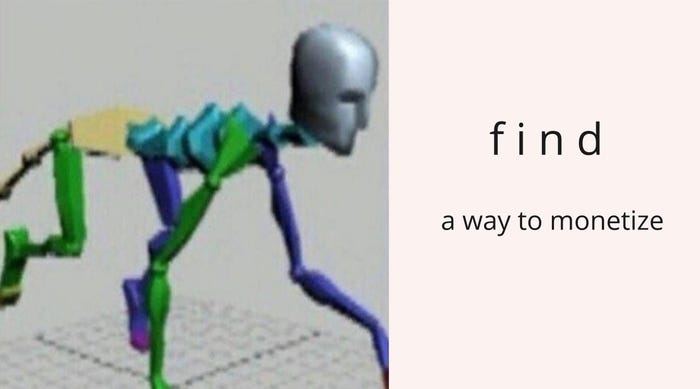
"When bankers gather, they talk about art. When artists gather, they talk about money."
Oscar Wilde
Imagine: you've developed an amazing game. It’s engaging, immersive, and... absolutely free. But what about making a profit? Let’s acknowledge the obvious: game development is not charity. Developers need to earn money for their work so they can keep creating new masterpieces for their fans. If we just want to make a game for our own enjoyment, we could share it with family and friends for a few laughs. However, for a game to launch on the broader market, it needs to be profitable — covering development costs and supporting you, your colleagues, and investors.
Players: 'I just want everything for free, and no ads, please!' Developers: 'Of course, why not? We don’t need salaries.' In reality, it’s like walking into a restaurant and demanding a truffle burger for free because 'I just want to eat!'
The question isn’t how to make money, but how to make money without disappointing players. That’s where the magic of smart monetization comes in.
So, the goal is clear: monetize the game in a way that fattens your wallet while keeping players happy. By reading this comprehensive guide, you'll learn how to successfully monetize games, explore monetization strategies, and discover the latest trends in monetization.
This chapter is the second key one in this material. If in Chapter 4, we built the economic foundation and walls, now we're building a grand roof with pagodas that will ensure financial protection and prosperity for your project.
The topic of game monetization has existed for a long time but continues to evolve daily. If you look at a popular game from 1998 and a similar one from 2024, you’ll see how much monetization methods have changed. It wouldn't be a stretch to say there was almost no monetization back then. :) People’s understanding in this area also varies greatly — some know the basics, since we all visit stores and see red price tags, while some readers are more advanced in this topic.
And yes, I mentioned red price tags for a reason — the methods used by giants like Amazon and Walmart are not much different from those used in Candy Crush Saga, Royal Match, or Diablo IV.
Moreover, the sales market is one of the oldest out there, with real user data filling vast data centers, while millions of specialists work daily to find ways to sell you just a bit more. Strangely enough, many of their techniques work well in games too. Why? Because the foundation of any market, whether it's virtual swords or real goods, lies in the same principles — human psychology. Some like a discount, some buy out of habit, and some simply can't resist a limited offer.
Isn’t it remarkable that, with the right approach, even a simple game can become a source of income for you over the next few years? The secret lies in the right choice of monetization tools, skillful combinations, and a deep understanding of your player.
Let’s start with the basics again: what currency will be used in your game?
Many game designers choose not to reinvent the wheel and simply implement the most standard system, where player earnings are represented by gold or precious stones. Imagine gold that players can earn in battles or purchase for real money — what could be simpler or more effective? This approach is universally understood, which is why it's so widespread.
Interesting fact: Why do hard currencies (typically crystals bought with real money) exist in games? The answer lies in player psychology and behavior. Using virtual currency reduces the psychological barriers associated with spending real money. Studies show that players are more willing to spend virtual currency as it’s perceived as less valuable than real money. [10] That's why stores encourage you to top up your in-game wallet first and then make purchases.
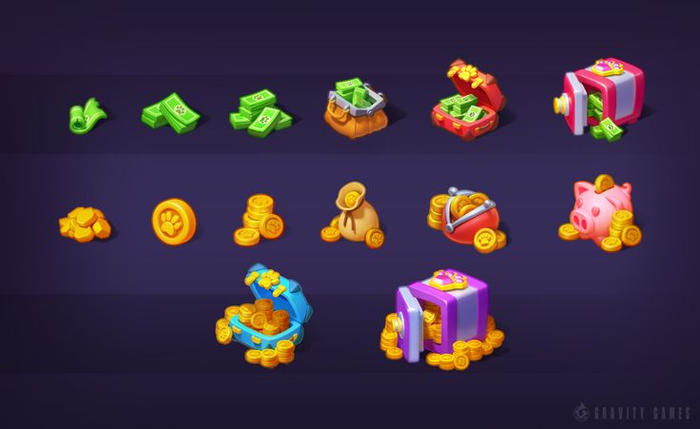
Some games go further, offering more complex currency systems based on resources or personal items, adding depth and diversity to gameplay. For example, in strategy games, resources like wood or iron are used for building and development. These aren't simply lying in a wallet but are an active part of the game process.
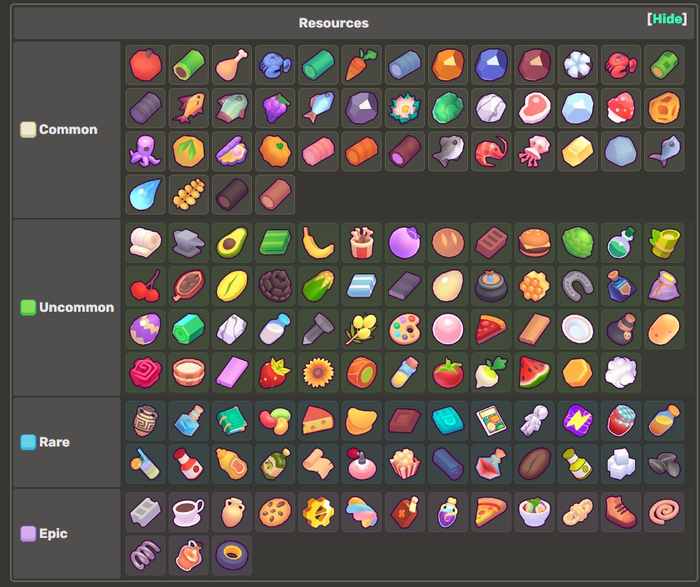
Dreamdale resources for sale
With the advent of blockchain technology and cryptocurrencies, we’re witnessing a new wave in the gaming industry. Blockchain-based games offer players the chance not only to play but also to earn real money by buying and selling virtual assets.
Imagine a game where each sword, armor, or even piece of land is a unique digital asset that can be auctioned or exchanged for cryptocurrency.
Example: Illuvium, an Ethereum-based RPG where players compete for ETH.
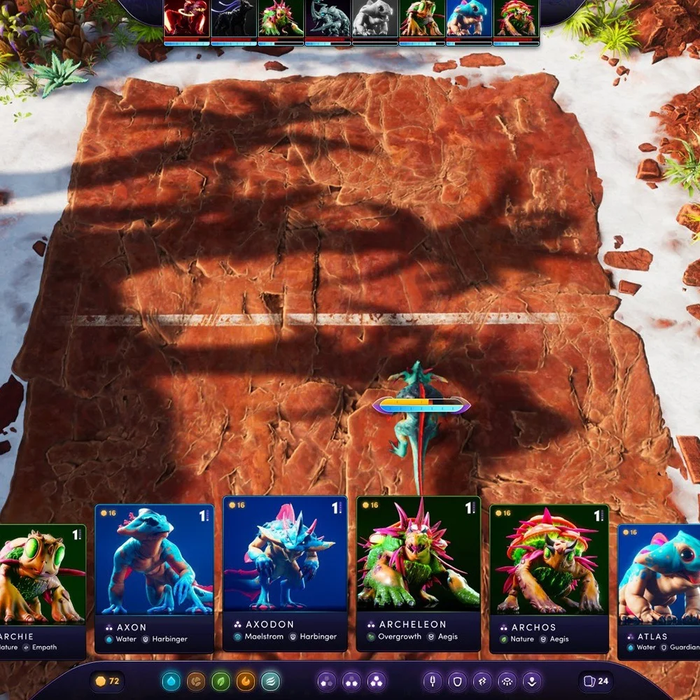
This topic is speculative, so I won’t delve too deep here, but the idea of using a currency that can be converted into real money is certainly inspiring. We all saw the viral success of Hamster Kombat with its 40–45 million daily active users (DAU).
Now that we’ve figured out currencies, let’s move on to how we can make money from a game. Monetization models are the heart of your game’s financial health.
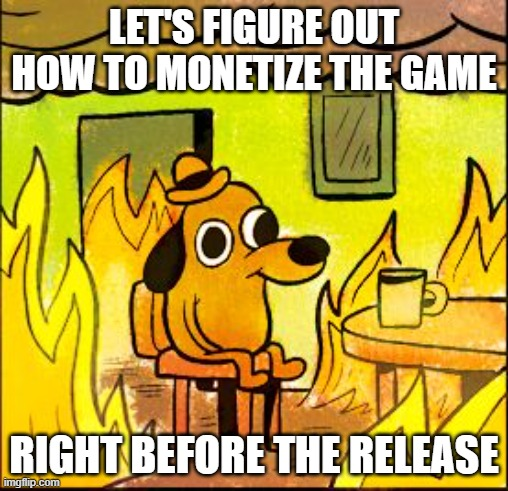
Choosing the right monetization model is fundamental to a game’s success, and this decision needs to be made early in development. If you think you can tackle this later, you risk serious issues when the game launches. Your revenue strategy should be defined at the earliest stages, as it influences many aspects of the game: from UI and level design to features and meta elements. [16]
Perhaps the worst thing a game designer can do is to ask, "What are we going to sell?" when the mechanics are already complete and implemented. All monetization methods should be considered in the design documentation stage.
Developers want to earn as much as possible, while players want to enjoy games for free.
Many developers pursue profit to the point of neglecting their players. They ruin the user experience, players get frustrated, and end up deleting the game. How to avoid this is discussed in Chapter 4, Game Economy and Balance.
Players understand that developers need money, and thus expect monetization elements in mobile games. The key is to avoid going overboard, allowing you to retain and convert players into paying users.
In-app purchases are the leading monetization model for mobile games. According to Business of Apps, 79% of mobile games monetize through IAP. This model forms the foundation of the so-called freemium economy, combining free and premium content in F2P (Free-to-Play) games.
In freemium games, players can install and play for free, but if they want a premium experience, they can make in-app purchases. These can include additional lives, in-game currency, weapons, boosters, and more.

At the center of nearly every game economy is the in-game store, where players can purchase various items. There are two main types of goods:
Consumables: The most common purchases, such as in-game currency, boosters, or health packs. Once used, these items disappear, and the only way to get more is to make another purchase.
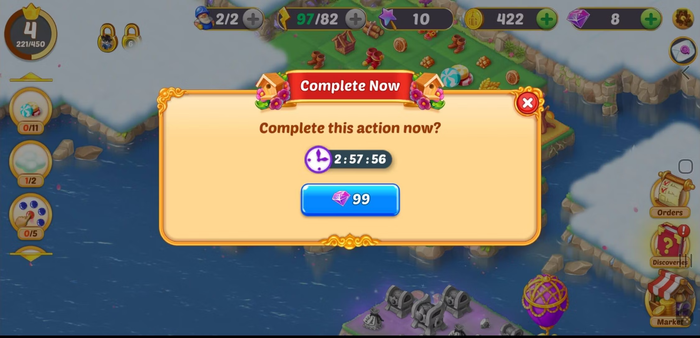
Non-Consumables: Items that are purchased permanently. For example, access to a new level, character, or cosmetic item. These items don’t disappear after use.
In IAP, time-limited offers and bundles are also popular — different goods packaged together for a special price.
In-game ads are the second most popular monetization model, where developers earn money by showing ads to players. In this model, players get all game features for free but must watch ads during gameplay.
Interstitial Ads: Full-screen ads that often appear during natural gameplay pauses, such as between levels.
Rewarded Video Ads: Players can voluntarily watch an ad to receive rewards, such as in-game items or currency.
Banner Ads: Static rectangular ads that appear in designated areas on the player’s screen.
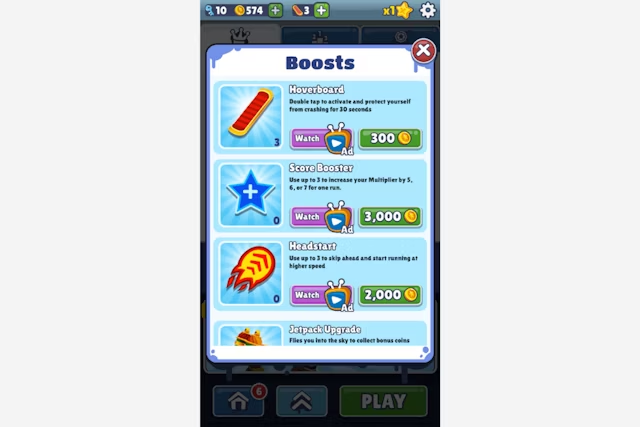
Ads are when your game adventure turns into a show featuring sushi restaurants and microloan offers. Nothing disrupts an epic battle like an ad for a new carpet-buying plan. In Budget Adventure, ads replaced the final victory scene with a promo code for free pizza.
It’s important to remember that ads can be an effective way to monetize, but it’s essential not to overdo it so as not to annoy players.
Advertising is generally viewed negatively, both by players and developers, for some valid reasons. We discussed this in Chapter 3: Player Psychology — Game Difficulty and Ads. Most players don’t want to see ads in the middle of an engaging gameplay session, right?
Throughout my career, I’ve often encountered developers who refused to include ads in their games. But after implementing ads in minimal areas, project revenue increased by 20%, and players received a non-forced (only optional) way to earn desired bonuses.
In other projects I’ve worked on, like Dreamdale with $20 million in revenue, ads made up a significant portion of the income. Without ads, the project would have earned much less.
Does this mean every project should incorporate IAD? Not necessarily.
In fact, according to recent studies by AppMagic, games that rely solely on ad placements (mostly hyper-casual games) are shifting toward the IAP monetization model. This is due to rising user acquisition costs; acquiring users in the U.S. for $0.05 per install is now more myth than reality, something left behind in 2020. To recoup user acquisition costs, ranging from $1 to $20, relying on ads alone is insufficient.
Subscriptions are a powerful monetization tool in game stores, generating steady revenue and increasing player retention. Let’s explore the different types of subscriptions and why they are so successful.
Battle Pass: A Battle Pass is a subscription model that encourages players to keep playing to earn unique rewards. This model is widely used by giants like Brawl Stars from Supercell, where the Battle Pass has become a major revenue source. Players pay for access to exclusive missions and rewards, motivating them to spend more time in the game and return regularly. [16, 1]
Remove Ads: This simple yet highly effective monetization method often serves as a “first payment” with a low entry barrier, converting free users into paying ones. In casual and hyper-casual projects, removing ads can contribute up to 80% of total revenue. [18, 19]
VIP Subscription: VIP subscriptions offer players exclusive benefits and bonuses unavailable to regular players. This model is especially attractive to “whales” — players willing to spend significant sums on the game.
Below are the main pros and cons of using subscriptions. [20]
Better Commission Rates: Subscriptions offer more favorable commissions after the first year on iOS (increased by 50%) and immediately on Google Play.
Recurring Payments: The primary advantage of subscriptions is the recurring payments that provide a stable income stream.
Trial Periods as a Conversion Tool: A trial period is a powerful tool for attracting users.
High Retention Rates for Subscribers: Subscribers generally stay active longer than regular paying players, contributing to stable revenue.
Multi-Tier Subscriptions: Offering different subscription levels allows you to reach a broader audience by providing various packages and bonuses for different player categories.
Increased Player Retention: Subscriptions motivate players to stay in the game longer as they receive regular bonuses and exclusive offers.
Risk of Cannibalizing Other In-App Purchases (IAP): Care must be taken to ensure that subscriptions do not start replacing other in-app purchase types.
Examples:

In the game, it’s often best to have both a subscription and a battle pass — there’s no reason to forgo one or the other.
Hybrid monetization combines multiple monetization models simultaneously. This helps developers leverage different income sources and monetize more players.
For example, you might combine in-app purchases and ads to make money from both paying and non-paying players. This approach is especially common in mobile gaming.
Unfortunately, there is no one-size-fits-all answer. However, I can help guide you.
When choosing a monetization model, first consider your game genre. Different genres require different monetization approaches.
For example, hyper-casual games rely almost entirely on ads. On the other hand, mid-core and hardcore games primarily depend on IAP.
You can also observe how your successful competitors monetize games similar to yours. Just play their games and pay attention to how you feel as a player; this can help you understand what might work for your game.
Game monetization is a relatively new industry and, as in any evolving field, new discoveries are constantly being made. Companies regularly A/B test new features; most fail, but some increase product metrics — these are considered successful tests.
Successful tests are then adopted by other companies, who learn about them through manual monitoring of competitors or through analytics services like Game Refinery, data.ai (formerly App Annie), or SensorTower. If these strategies are successful in other games, they are considered proven strategies.
I’ll now share some truly proven monetization strategies. These monetization improvement techniques form a base that works in almost all projects.
Monetization expert Mikhail Khripin discusses these strategies in more detail in his new book, Best Practices for In-Game Shops, which I highly recommend. In this article, I’ll only touch on my favorites and a bit more.
Now, let’s go from simple to complex.
One of the most effective and simplest strategies for increasing initial conversions is to offer a substantial one-time bonus for the first purchase. Imagine offering players up to 600% bonus on their first or second purchase. This is a powerful incentive that’s hard to ignore.
!img25.jpg
Offer “Buy 1, Get X Free”: A compelling offer that increases the value of the first purchase, making it very attractive for players.
Exclusive Starter Packs: Offering exclusive items or resources that can’t be obtained elsewhere encourages players to take advantage of the offer for unique benefits.
Discounts and Coupons for Future Purchases: Significant discounts (up to 600%) after the first purchase create a sense of limited-time benefit, prompting players to act immediately.
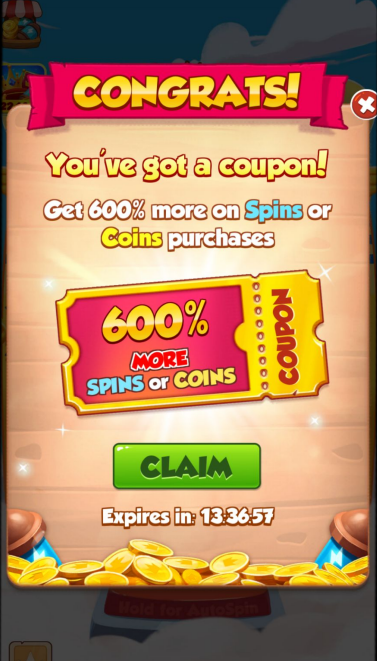
An advanced way to increase in-game store revenue begins with segmentation.

Depending on the player’s status, the game adapts to them
The first step is to segment players — dividing them into groups based on various parameters like behavior, preferences, activity level, and spending potential. This allows you to offer products and services most relevant to each group.
For example, it’s worth offering beginners starter packs to help them get settled into the game, while experienced players might be offered exclusive high-level items.
Segmentation can be based on data such as:
Payment Amount and Frequency: This allows you to determine a player’s spending potential.
Purchase History: Helps you understand a player’s preferred items.
Game Progress Level: Allows you to offer more complex and valuable items for experienced players.
After segmentation, the next step is to personalize offers. This means that the in-game store starts adapting to each player, offering exactly the items they need at that moment. This approach significantly increases the likelihood of purchase.
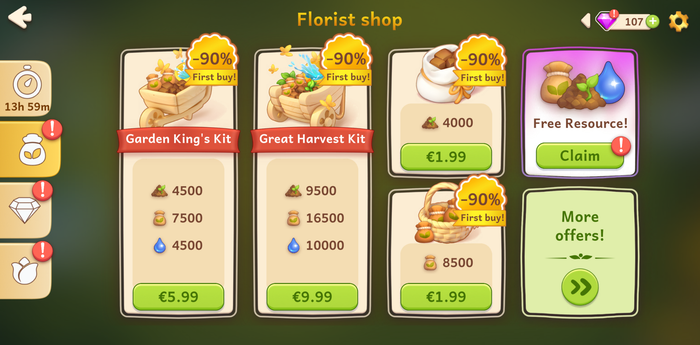
Real Game Example: In a recent Florescence update, the in-game store was set up to adapt to each player's in-game needs. For instance, if a player was short on soil and fertilizers, they would find these items in the store. This personalized display helped increase store revenue by 41%. The development team also implemented segmentation, new price categories, and added thematic sections, including a daily discounts section, where players could buy items at a reduced price once a day. These improvements led to a 46% increase in the store’s share of total purchases and a 26% increase in overall revenue. Additionally, “daily offers” became the leader in terms of purchases, overtaking the previous leader by 1.5 times in sales and doubling in revenue. [20]
Key Personalization Principles:
Tailored Offers: The store automatically offers the player items they genuinely need. For example, if a player frequently buys boosters, they might be offered a special booster pack at a discount.
Activity-Based Segmentation: Active players receive more offers and discounts than those who play less frequently.
Dynamic Offers: In Hunt Royale, the system automatically creates and updates offers weekly based on the player’s behavior and inventory. This led to a significant increase in in-game purchase revenue.
Another proven strategy for increasing game revenue is offer sequences — a method of presenting players with a series of offers that gradually adapt based on their buying behavior. This approach helps maximize conversions and revenue, while keeping players interested in in-game purchases.

Price Anchoring: Start with a low-price offer (e.g., a starter pack for $2) to attract attention and establish a baseline for subsequent offers.
Adaptive Offers Based on Purchases: If a player buys the starter pack, they are offered the next higher-priced offer (e.g., $10). If they don’t buy the starter pack, they’re offered a discount or cheaper alternative (e.g., $1).
Stepwise Price Increases: After purchasing the $10 offer, the player might be presented with higher-priced offers, like $20 and $50. In case of refusal, intermediate options (e.g., $2 and $5) are offered.
Iteration and Testing: Regular A/B testing of different price levels and offers to determine the most effective options. Iteration using content, prices, and discounts to optimize offers.
Modern game monetization approaches are increasingly incorporating machine learning (ML) — often referred to as AI — especially for user segmentation and optimizing offer sequences. ML allows automated adaptation of offers for each player based on their behavior, preferences, and likelihood of purchase.
Machine learning (ML) has become indispensable in game monetization, especially in user segmentation and customizing offer sequences. ML algorithms help to automatically tailor offers based on player behavior, preferences, and purchase likelihood.
ML algorithms use a point system assigned to each user based on multiple factors, such as location, activity, purchase history, and demographics. These scores range from 0 to 100 and indicate the likelihood of a player becoming a high-spending customer (often called “whales”).
User Segmentation Based on Scores
Each user is assigned a score (from 0 to 100), reflecting their potential value as a customer. These scores are calculated based on several factors, including:
Location: Geography can impact spending habits and affordability.
In-Game Activity: Time spent in the game, frequency of play, and activity levels.
Purchase History: Frequency and amount of previous purchases and preferred items.
Social Parameters: Engagement with other players, participation in clans, or tournaments.
Example: A player who spends 2-3 hours in the game daily and has made prior purchases may have a score of 60, placing them in Tier 3.
Determining the Initial Offer
Each tier has a base offer tailored to what players in that group are likely to spend.
Tier 0 (0-10 points): Minimum offer — a $1 package.
Tier 3 (50-70 points): Mid-level offer — a $10 package with bonus items.
Tier 6 (90-100 points): VIP offer — a $50 package with exclusive content.
Example: A Tier 3 player might be offered a rare item for $10.
Adaptive and Personalized Offers
Based on user response (purchase or decline), the algorithm adjusts further offers:
If the offer is accepted: The player is offered a higher-priced, more valuable offer, such as $20.
If the offer is declined: The system may lower the price or present an alternative, cheaper offer to encourage a purchase.
Example: A player accepts a $10 offer, leading to a $20 package suggestion. If they decline, they are shown a $15 intermediate offer.
Using ML to Optimize Offers
The ML algorithm learns from all users, predicting which offers are most likely to succeed for each player.
Example of the Algorithm at Work:
The algorithm analyzes behavior across Tier 3 players and finds that 70% prefer time-limited discounts.
Based on this, all new Tier 3 players receive time-limited discount offers instead of standard deals.
This example is simplified; the number of parameters and complexity can vary based on a company’s investment in ML development. ML models can continually improve with data, using reinforcement learning for real-time adaptation based on player actions and revenue impact. For example, if a player repeatedly declines a $20 offer but buys a $15 one, the algorithm will optimize future offers around this preference.
Decision Trees are simple structures that make decisions by asking questions that lead to data splits. For example, a tree might first ask: "Does the player spend more than 2 hours a day in the game?" If the answer is "yes," it could follow up with the question: "Did the player make any purchases last month?" Depending on the answers, the tree classifies the player and suggests an appropriate offer.
Random Forest creates hundreds or thousands of such trees, each making its own decisions based on random subsets of data. The algorithm then gathers "votes" from all the trees and makes a final decision based on the majority. This algorithm can be used for complex analyses of player behavior and identifying the factors that most strongly influence their purchasing decisions.
Example: In a game, data from many players can be analyzed to identify key indicators that predict successful purchases. For instance, activity in the game's social features (participation in guilds, chats) may be a strong indicator of a player's tendency to make purchases.
Risks: Imagine this scenario—you have already set up the model and rolled it out to all users, with thousands of bundles and special offers being sent to players' devices. But after two weeks of testing, you find that you earned 30% less revenue compared to not using ML. What went wrong?
This was a real case faced by a game design colleague of mine, which led to their company abandoning the use of ML. As you might have guessed, the problem was that the system was making offers that were too attractive for players. Items that were hard to obtain naturally were being offered at extremely low prices. The mistake lay in the configuration. Therefore, it is crucial to thoroughly test such systems, and they may not always function correctly without competent specialists overseeing them.
There is much more to be said on this topic, but that is a story for another time. If you are interested in learning more about ML algorithms suitable for game monetization, you might want to read about XGBoost and K-Means. Feel free to leave comments if you'd like me to elaborate on this.
Now that we have set artificial intelligence into battle mode and taught it to segment players and offer the best deals, can we relax? Not quite! If the world were that perfect, we would have already launched Skynet for monetization, and the game would be making millions by itself. But, unfortunately, things are not that simple. No matter how well we train our algorithms, classic issues will still arise that test the resilience of any game economy.
One frequent issue developers face is cannibalization, where a new paid item reduces sales of existing ones without increasing overall ARPU (Average Revenue Per User). For example, introducing a new booster that renders older ones less effective could lead to lower sales for existing items without increasing spending.
How to Address This? Ensure that new elements complement rather than replace old ones. In a balanced ecosystem, even boosters have their place.
Hyperinflation happens when in-game currency becomes so abundant that it loses value, leading players to lose motivation to earn it. In Diablo 2, for instance, gold became so devalued by the end of the game that players stopped using it, instead trading items like the Stone of Jordan.
Solution: In Chapter 2’s “Resource Sources and Spending Points” section, we discussed managing resource flows. Analyze resource sources and spending points carefully to correct issues here, as it’s often the root of in-game economy problems.

Example: In the game Whiteout Survival, currency that’s abundant early on becomes necessary in large quantities for late-game land purchases. Initially, players might wonder why they have so much money, but later they find they can’t get enough of it.
Introduction of new, more valuable resources or currency that is harder to obtain and/or can only be acquired through other mechanics. This creates new goals for players and additional incentives.
Sometimes this is the only way to combat hyperinflation. For example, in the idle game genre, where prices increase exponentially, players eventually stop comprehending the numbers on the screen, making hyperinflation commonplace. After 1k (1,000), 1m (1,000,000), and 1b (1,000,000,000), the system moves to 1aa, 1ba, 1AA, and so forth (all shorthand for larger numbers).
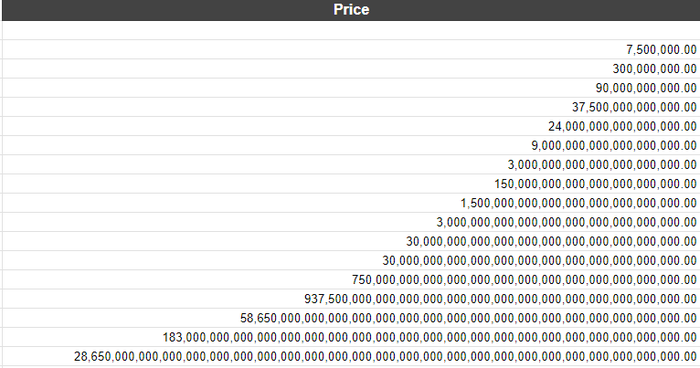
Exponential rise of idle game currency prices
Unfortunately, every large economy eventually has to deal with bad actors. In games, these troublemakers are known as cheaters.
Scenario: Cheaters found a way to generate unlimited amounts of in-game currency (crystals, coins, and other resources), allowing them to acquire items and upgrades without real expenses. Analytics showed a sharp increase in activity — players started massively spending crystals and other resources, creating the impression of a highly active game economy. Based on this data, developers decided to raise the prices of in-game items and services, assuming players were willing to pay more. However, monetization revenue didn’t grow, as honest players couldn’t afford purchases at the new inflated prices. This led to user attrition and a damaged game reputation.
How would you restore fairness for regular players and correct the misguided decisions based on cheater activity?
Data Filtering: Adjust analytics systems to exclude suspicious data from cheaters or players with abnormal activity in the future. This will prevent similar errors in decision-making.
Automated Anomaly Monitoring: Implement a system to track suspicious spikes in activity and automatically alert the development team. This will help detect cheater problems early, before they cause serious damage.
Anti-Cheat Mechanisms: Introduce advanced anti-cheat technology to detect and block cheaters in early stages. Use machine learning systems to identify suspicious patterns in player behavior.
After exploring key monetization aspects — from currency systems to machine learning — it’s clear that successful monetization is about balance. You need mechanics that generate revenue without driving players away.
Questions for Reflection:
Which monetization model is most subtle to players, and why?
Why might it be risky for developers to apply ML to personalized offers without fully understanding the algorithms?
How much of your game are you willing to give players for free?
Which monetization tool works best?
Your game can become a significant revenue source by using advanced strategies: player segmentation, personalized offers, and careful resource management within the game economy. But monetization comes with risks. Pushing players too hard, hyperinflation, and cannibalization are just a few of the challenges.
That’s why each element of monetization requires not only careful planning but also regular adjustments based on analytics and data. How can this be done?
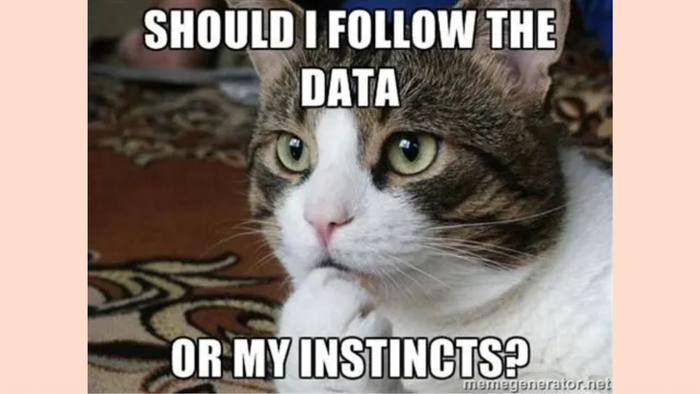
"Ignorance is the night of the mind, a night without moon or star."
Marcus Tullius Cicero
If monetization is the heart of a game that determines its financial health, then analytics is its nervous system. Without understanding how players interact with your product, which strategies succeed, and which fail, building a sustainable long-term economy is impossible.
Why is Analytics Important?
Games are more than just cool mechanics and great graphics. Today’s successful projects are built on data. Analytics allows you to understand player behavior, identify weaknesses, optimize the economy, and increase revenue. This is crucial, as without insight into how players interact with a game, monetization success becomes a matter of chance.
Without data, you are like someone trying to defeat an opponent blindfolded—you don’t see where you’re hitting and can’t understand why you’re losing.
In this chapter, we’ll dive into the role of data and analytics in game development and examine how to use this information to enhance monetization and overall project success.
To start, let’s look at what kind of data we need to collect, the types of metrics in games, and then move on to analyzing them.
Unlike typical materials that merely mention metric names, this article provides specific examples and explains why they are so important for you as a developer. Some go deeper than standard definitions to help you better understand how to work with data.
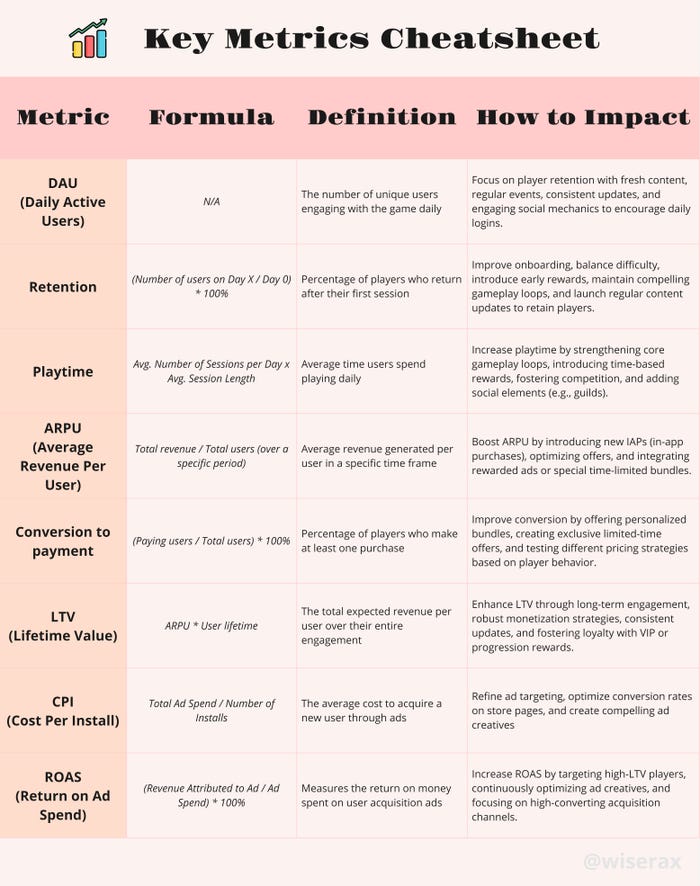
Key Metrics Cheatsheet
What to track?
DAU/MAU (Daily/Monthly Active Users) – Indicates the number of unique users per day/month and their ratio, helping to measure player activity and engagement.
LTV (Lifetime Value) – LTV shows the total revenue a player brings throughout their interaction with the game. This fundamental metric is crucial, as it determines a game’s profitability. A successful game follows the standard rule: LTV > CPI (Cost per Install). If the average revenue from a player exceeds the acquisition cost, the game is considered profitable. LTV can range from a few cents in hyper-casual games to hundreds of dollars in titles like Genshin Impact or Lineage M. For instance, in Lineage M, LTV per player can reach $448!
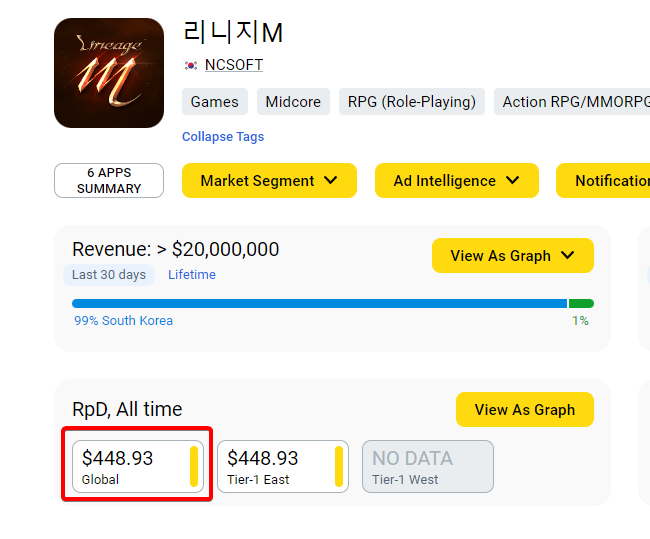
RpD - Revenue per Download
Retention Rate – The percentage of players returning to the game after a set period (e.g., Day 1, 7, 30), a key metric for user retention analysis. Low retention can indicate gameplay issues.
Churn Rate – The percentage of players who stop playing over a specific period. A high churn rate signals engagement issues.
Session Length – The average game session duration. Long sessions suggest high engagement, while short ones may indicate weak interest or design issues.
Session Frequency – The number of times a player returns to the game within a period (e.g., daily). High frequency suggests good engagement and monetization potential.
ARPDAU (Average Revenue Per Daily Active User) – The revenue per active user daily, showing how effectively the game monetizes its active audience.
ARPU (Average Revenue Per User) – The average revenue per user over a set period.
Example: If your game has 1,000 active users and total daily revenue is $1,000, then ARPU would be $1. If only 50 out of those 1,000 players made purchases, ARPPU would be $20.
ARPPU (Average Revenue Per Paying User) – The average revenue from paying users, helpful for assessing how well the game motivates players to make purchases.
Example: In Budget Adventure, there are few paying players, but those who remain spend enough to cover others. TommyTheTapper spends a few hundred dollars a month in the game. However, 99% of players don’t buy anything. ARPPU skyrockets, but ARPU remains low as most players choose to leave rather than pay.
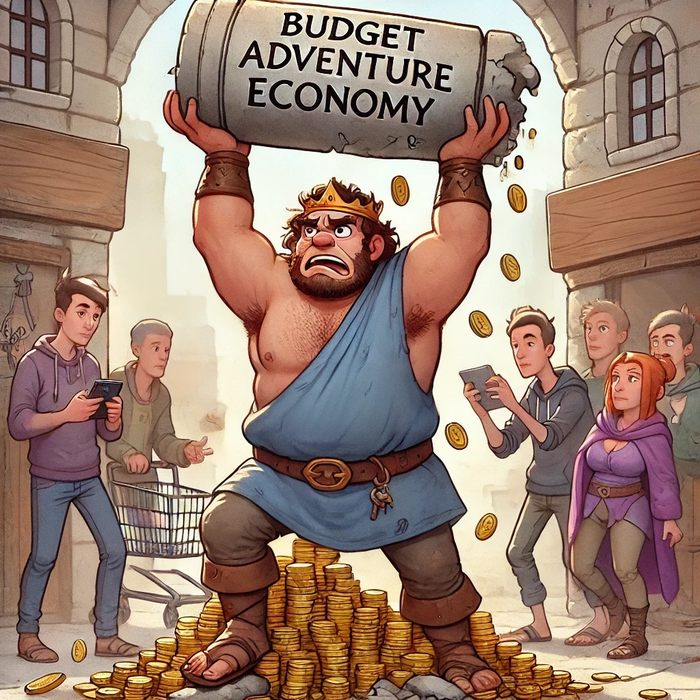
TommyTheTapper controls the entire economy of Budget Adventure – a common situation for small-scale games.
Conversion to Payment Rate – The percentage of users making a purchase, an essential metric for monetization analysis.
There are various types of this metric, such as conversion to second or third purchases. Even when a project is doing well and players make their first purchase, work on this metric never stops.
Progression Rate – the speed at which players progress through game content and when they make purchases. This helps to understand player behavior at different points in the game cycle.
Now that we’ve identified key metrics, how do we gather all this data and, more importantly, make sense of it? This is where data analytics and visualization tools come in. Let’s be honest: data analytics is a separate profession. And, most likely, game designers won’t handle it themselves (although, who knows, maybe you’ve always dreamed of becoming an analyst at heart?).
"I hope we won’t have to dive into complex formulas and endless tables… But a little knowledge never hurts, especially for a game designer!"
What does this mean for us?
Teamwork: Usually, teams have designated data analysts who collect and process information.
Ready-made dashboards: We receive pre-made dashboards and reports. Our main task is to interpret the data correctly and make decisions.
How to Work with Analytics Tools?
Tableau, Power BI, Looker: These tools help visualize data, turning raw numbers into comprehensible graphs and charts.
Firebase, GameAnalytics, Mixpanel, Unity Analytics: These tools collect real-time user behavior data.
Imagine a real situation: you’re examining the level completion funnel (Churn rate) in your game:
Level 1: 100% of players completed it – great!
Level 2: 95% completed – still good.
Level 3: 90% completed – a small decrease, but nothing critical.
Level 4 ("Spider’s Den"): Only 70% completed it.
<p><code class="excel language-excel">BAM! You see a significant red drop.</code></p>Questions to Consider:
Why do 20% of users leave the game precisely at this level?
Could it be that the level is too difficult?
Are there technical issues?
However, you notice an interesting fact: "Spider’s Den" brings in $80,000 from in-game purchases and $75,000 from ads – the highest of all levels!
What to Do?
Dive deeper into data analysis: It’s possible that the remaining 70% of players are so engaged that they’re willing to spend money to pass the level.
Balance the difficulty: Perhaps you should slightly lower the level’s difficulty to retain more players while preserving the incentive for purchases.
Test changes: Run A/B testing by creating two versions of the level and comparing the results.
How would you handle this scenario? Is it worth sacrificing part of the revenue to increase retention? I’ll leave these questions open for your reflection but suggest a framework for tackling such issues.
Step 1: Identify the Problem
Observe a significant player drop-off at a specific stage.
Step 2: Gather Additional Data
Analyze player behavior: How long do they spend on the level? What actions do they take?
Collect player feedback: Is the level too challenging or uninteresting?
Step 3: Generate Hypotheses
Is the level too hard?
Are there bugs or technical issues?
Is the level design unsuccessful?
Step 4: Implement Changes and Test
Make adjustments to the level and track how it affects metrics.
Continue monitoring data and adapting the strategy.
Tip: Continuous interaction with data enables informed decision-making and quick problem-solving.
As discussed earlier in Chapter 5: Monetization, "whales" are a unique category of players willing to spend significant sums in a game. We highlighted the importance of creating tailored offers and personalized options for these players to enhance their engagement and spending.
Research in "Out of the Box Thinking: Improving Customer Lifetime Value Modelling via Expert Routing and Game Whale Detection" shows that early identification of high-spending players can significantly improve LTV prediction models. These players often exhibit behavior patterns distinct from the general user base.
What Does This Mean Practically?
Collect Detailed Data: Use analytics tools to gather data on player behavior, track session frequency, in-game time, purchases, and social interactions.
Audience Segmentation: Divide players into segments based on their activity and spending capacity. This helps you focus efforts on your most valuable users.
Personalized Offers: Create special offers for different segments. For instance, for "whales," you might offer exclusive items or VIP status.
Analyze and Adapt: Constantly review the effectiveness of your strategies and make adjustments based on the data.
Example in Practice
Imagine that in your game, you notice a player, "DiamondKing", who has spent $3,000 over a week. Analyzing his behavior reveals that he actively participates in PvP battles and values rare collectible items. Data analysis shows that if he doesn’t log in for more than two days, his likelihood of leaving permanently increases sharply.
Your Actions:
Offer him an exclusive PvP gear package.
Invite him to a private community of top players.
Send reminders about new premium content or simply notify him of fresh updates.
Interesting Fact: In some games I’ve worked with, "whales" accounted for less than 0.001% of the total player base but contributed over 50% of the revenue.
Let’s see how Supercell segments its players in the popular game Hay Day.
How It Works:
Ads for Non-Spenders: Players who reach level 10 without making purchases gain access to the "Night at the Movies" section, where they can watch up to four ads daily for random rewards.
Bonuses for Paying Players: Once a player makes their first purchase, ads are disabled for them. Now, they can just visit this section and collect rewards.
This approach monetizes all types of players, including non-payers, while paying players feel rewarded, encouraging further purchases.
Imagine it’s 3 AM on a Saturday, and by chance, only very wealthy players are in your game…
Few games are ready to leverage and handle such situations. Data from tests lets you see how players spend their resources and identify potential bottlenecks in game mechanics before the main release.
There are "sensitive points" in a game’s economy—parameters that greatly influence balance. It’s like playing Jenga: the very block that, if removed, makes the entire tower fall.
Your job is to identify which parameters are control points and which are not critical.
Once the game goes live, the real work begins! It’s like keeping a pulse on a patient—the analytics will indicate if the game economy is healthy or if it needs urgent "treatment." Without ongoing monitoring, you may miss moments when players start leaving due to unbalanced pricing or high difficulty.
Questions to Consider:
If you could only track one game metric, which would it be, and why?
Suppose unexpected data shows that where 5% of players used to drop off, now 30% are leaving. Would you change gameplay, the economy, or the analytics setup?
If one player generates more revenue than 1,000 others, how would you alter the game?
How would you react if players started completing a new level twice as fast as planned? Is this a design success or a signal for changes?
Do you think it’s worth sending a personalized offer to a player who leaves after a short session, or will it just reinforce their decision to quit?
Here we conclude our exploration into the world of data and analytics. If analytics once seemed like boring work for graph lovers, I hope you now see that without it, a project is like a ship without a compass, drifting blindly in a turbulent ocean. Remember: data is not just numbers; it’s the story of your players—their choices, journeys, victories, and defeats.
Now that you have all the metrics under control, let’s move forward and look to the future. Are you ready for what’s ahead? The next chapter, Trends and the Future of Game Economy, will answer this question...
"Repetition leads us nowhere — in fact, it diverts us from originality. The essence of creativity lies in using our skills and knowledge to invent rather than replicate."
Ed Catmull
Today, the gaming industry is not just entertainment but also a multi-billion-dollar business. As players become more discerning, developers are increasingly challenged to design innovative game economies. In this chapter, we explore key trends and look ahead to the future of game economics.
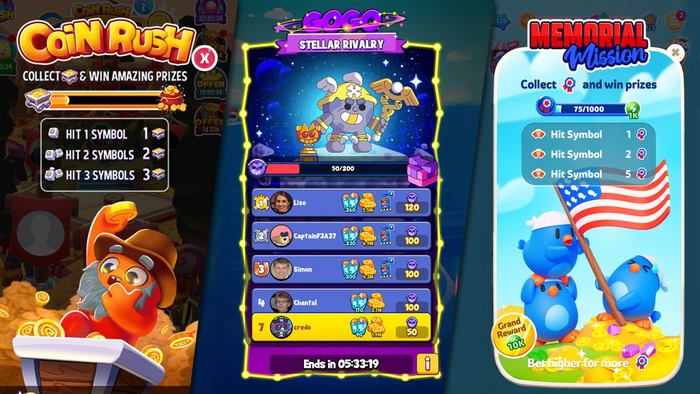
Examples of Limited Time Events (LTE)
LiveOps has proven to be stable for increasing revenue and retention. A timely event can easily multiply revenue. Personally, I've observed revenue spikes of up to threefold during such events. But what’s behind this magic word? Let’s dive in.
LiveOps is a system of Live Operations (abbreviated LiveOps) that supports the game’s lifecycle post-launch. I liked how Mila Pilipenko, former Lead Game Designer at Playrix, described LiveOps as essentially a calendar. A calendar of events and promotions tied to various holidays or significant dates, these events aim to offer players something unique and temporary that they won’t see in everyday gameplay. Whether it's exclusive gameplay, skins, weapons, or characters, it’s always limited seasonal content that eventually disappears.

This in-game calendar has more happening than my personal one!
How does it work? Imagine a player roaming familiar locations and completing routine quests for months (or even years). Even with constant new content, routine inevitably takes hold. Then, BOOM! A new event with special prizes, just for you, ending in only 7 days. The “need to grind” feeling kicks in, and players start engaging actively. This translates to more time spent in the game and, naturally, increased purchases. Everyone wins: players enjoy fresh content, and developers celebrate profits.
Research shows that such events not only draw back old players but also boost community engagement overall.
Now let’s address a more delicate topic—borrowing casino mechanics. Gambling is forbidden or taboo in many countries. However, mechanics like loot boxes, gacha, or roulette are powerful tools and have long been a staple in top games.
Why? Because it works. Leading games earn billions of dollars from these mechanics. Let’s look at some figures for 2024 (according to AppMagic):
Honor of Kings: $12.3 billion from in-app purchases (IAP).
PUBG Mobile: $8.5 billion from in-app purchases (IAP).
Genshin Impact: $4.4 billion from in-app purchases (IAP).
Brawl Stars: $1.76 billion from in-app purchases (IAP).
All of these games use loot boxes and other casino mechanics, and in some, they are the core of monetization. For example, in Brawl Stars, without gacha (loot boxes), you can’t unlock new characters, meaning you can’t fully play without spinning for chests.

Players love the thrill and uncertainty. Every time they open a chest or spin the gacha, they get a dopamine rush, dreaming of a legendary reward. It’s not just a random prize—it’s a whole psychological ritual. The anticipation of a reward, rarity of the drop, and time limits increase engagement. Every gamer has a little hamster inside, trembling with excitement for unique loot.
But there’s a flip side. Studies show a consistent correlation between loot boxes and problematic gambling [23]. A study commissioned by the UK Department for Culture, Media, and Sport noted that 15 studies confirmed a link between loot box spending and signs of problematic gambling. This issue raises concerns, and in some countries, such as Belgium and the Netherlands, loot boxes are already banned by law.
Game developers I’ve spoken with feel that casino work is undignified. I exist in game dev to create new worlds, captivate players, give valuable experiences, and help people grow and improve.
But the truth is, this monetization model will continue to thrive because it’s incredibly effective. The question remains as to how business and regulators can work together to integrate it with maximum responsibility.
All of us game designers inevitably make the same mistake: we try to impose prices from the top down, like deities deciding the worth of every item. A sword for 100 gold, a dragon for 5000. But what do we forget? Economics doesn’t like dictates. It needs to operate independently.
Imagine telling a farmer his carrots must cost 5 silver, and an immortality potion 5000 gold. What are the chances that someone will miss the mark in this calculation? I’d say 100%, because that’s not how it works.
Real-world economics doesn’t work this way either. No one goes to market and says, "So, chicken eggs will cost 50 today, and coffee, 300." The market decides for itself. Supply creates demand, and when someone starts artificially controlling prices, as governments sometimes do, the result is often disastrous. History offers many examples: a country tries to set fixed prices on goods, leading to shortages and black markets.
So why do we so persistently try to dictate the price of dragons and potions in our game worlds?
What if we allowed the world we create to set prices on its own? Imagine setting base parameters and then launching a simulation. For instance, if you’re creating an MMORPG in a fantasy style, all prices are set by us, the game designers; at best, players set their own prices at auctions or exchanges. Take EVE Online, where wars destroy game assets worth hundreds of thousands of dollars in real money. But it’s still child’s play.
What if the world lived on its own? What if every agent—from a spice trader to an ancient mage selling Rain of Fire Tome—decided the price of their goods based on supply and demand? This is where multi-agent AI comes in. These agents could trade, grow resources, and set prices based on availability, demand, and production complexity.
Imagine a bot farmer growing cabbage. If there’s plenty, it’s dirt cheap. But if the market suffers a bad harvest, prices skyrocket. A mage crafting a Rain of Fire Tome might sell it for a fortune if demand is high. Running such a simulation thousands of times would create a natural ecosystem where the economy lives by its own rules, not requiring your intervention. And prices would be more realistic than if you set them manually.
This all sounds great, of course, but let’s dive into the technical details. I remember how my university professor, Igor Vereninov, told us about the problem of solving binary trees. It’s a mathematical structure where each branch contains branches and nodes that can be solved in two ways: top-down (starting from the root) or bottom-up (starting from the leaf nodes).
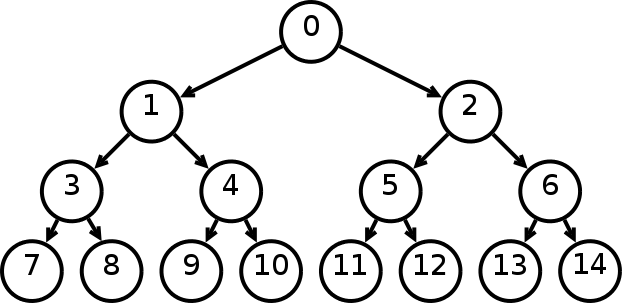
If you start from the tree’s “leaves” (i.e., the lowest elements) and try to work your way up, the complexity of the task grows exponentially with the tree size, as does the chance of error.
Why does this happen? Because each branch depends on the nodes above, and the nodes depend on the root. If you start from the bottom, you lack the data to make the correct decision because you can’t see the big picture; you’re solving problems in a vacuum.
Now imagine that your game economy is a massive binary tree with millions of branches. Each branch of the tree represents the price of an item in your game, from a can of pickles to a dragon steel hoe.
From a tree worth 1 copper comes a wooden plank worth 2 coppers;
From the wooden plank comes a cutting board worth 3 coppers and a wooden buckler worth 5 coppers.
From Cutting board comes...Would it be easy to solve such a massive tree? Of course not. Top-down, it’s practically impossible—too many variables, too many unknowns.
In my article The Perfect Simulation: How Chaos Makes the World Interesting [24], I talked about the importance of starting from the beginning by setting basic rules and elements and allowing the system to naturally find the right paths.
This is only about pricing systems within world economies. We haven’t even mentioned NPC diplomacy, market laws, city prosperity, and scarcity.
If a player burns all the fields near a major city, hunger should ensue. Or, conversely, if a player periodically invests astronomical sums in a small village, it should grow rapidly, with residents becoming wealthier and stronger.
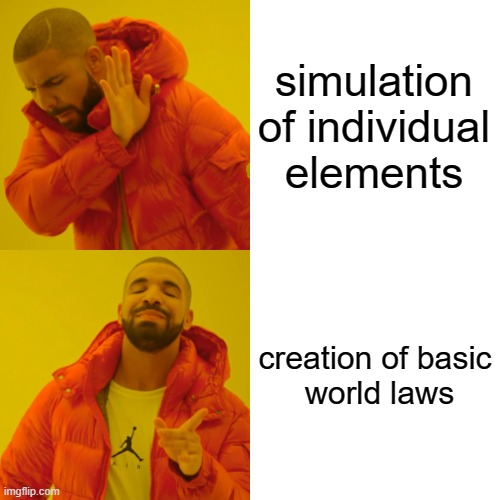
A comprehensive approach to simulation development makes worlds more realistic and lively.
Michal Korek, Head of Product at Hunt Royale, argues that vibrant animations and interactive elements have become the primary drivers of conversion and retention in modern game stores. A notable example is the store redesign in Hunt Royale, where a premium pass and seasonal pass revamp increased conversion by a shocking 52%.
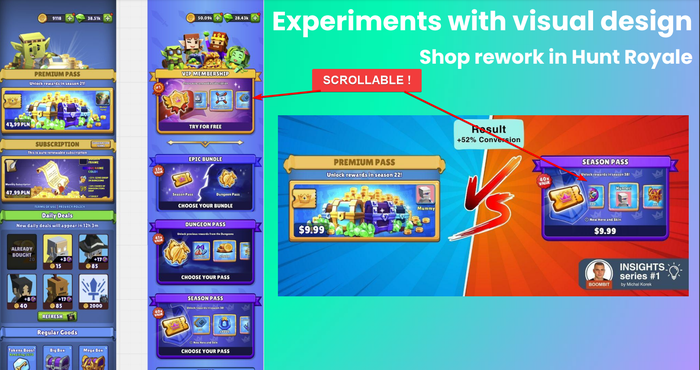
Full Animation in Stores:
Animations draw attention to new offers and create a dynamic interface.
Example from Brawl Stars: Brawl Stars store design
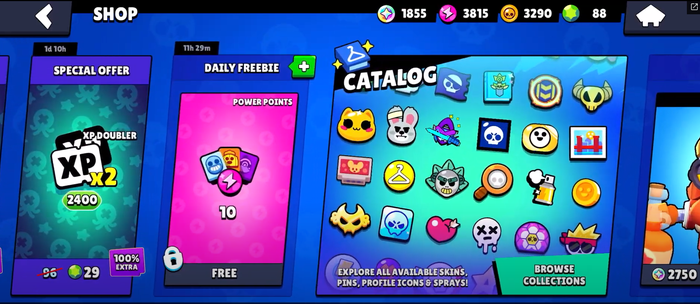
Animated Subscriptions:
Subscriptions with animated elements attract more attention and can boost conversions.Example from My Little Universe: animated subscription

Animated Offers:
Using animations in special offers makes them more noticeable and appealing. Example from SSSnaker: animated offer
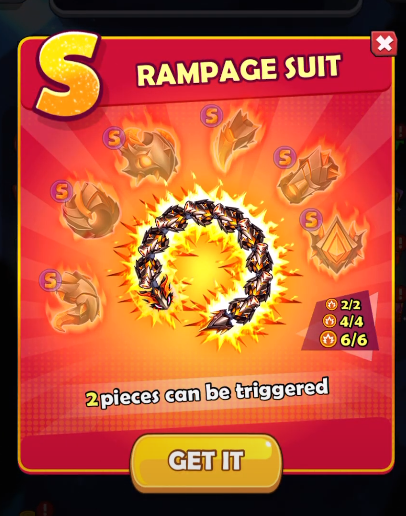
Recently, during a conversation with Oleg Nalimov, Executive Producer at AppQuantum, he pointed out that the 4X genre represents the pinnacle of mobile gaming evolution. But what is 4X? It’s a genre where players complete four main tasks: explore, expand, exploit, and exterminate.
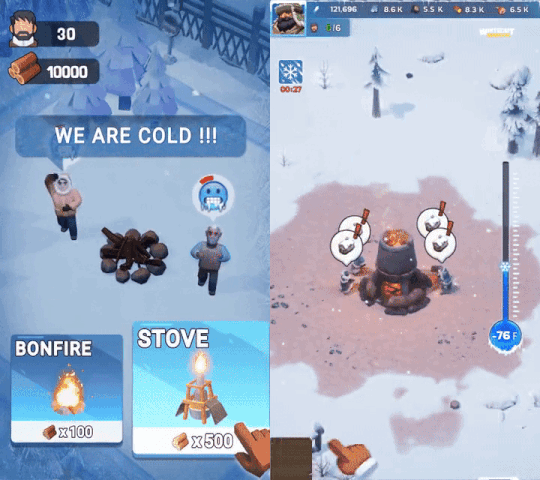
Left: Ad for Frozen City. Right: Ad for Whiteout Survival
The 4X genre is one of the most monetizable on mobile platforms, with numerous games exceeding $1 billion in revenue. Examples include Rise of Kingdoms, Lords Mobile, Game of War, and the recent hit Whiteout Survival.
Today, many developers are already incorporating 4X elements into their games, even if they’re not strictly strategy titles. Here are some core mechanics they borrow:
Base development: a powerful tool to enhance player return.
Farming: a farm-clicking mechanic has always been popular on mobile platforms.
Social interactions: alliances, cooperation, diplomacy, and, of course, PvP.
Combat and territory expansion
Interestingly, genre blending has become another significant trend in mobile gaming. Games like Top War and Puzzles & Survival add popular mechanics like match-3 or merging objects, making them more accessible to a broader audience.
In the future, we will likely see more games moving away from single-genre titles, such as pure action or pure arcade, incorporating more mechanics from adjacent genres to create mega-games (similar to mega-apps, which combine messaging, social media, shopping, and more).
The question for you: If 4X is the peak of mobile genres, what will be the next step in its evolution? What do you think about the future of mobile gaming? Share your thoughts in the comments.
There’s a trap many developers fall into when creating monetization for their games. Suppose you design a system full of paywalls, preventing players from fully accessing the game. This forces players to pay to gain an advantage over others. Just like that, you’ve created a pay-to-win game—a model players despise.
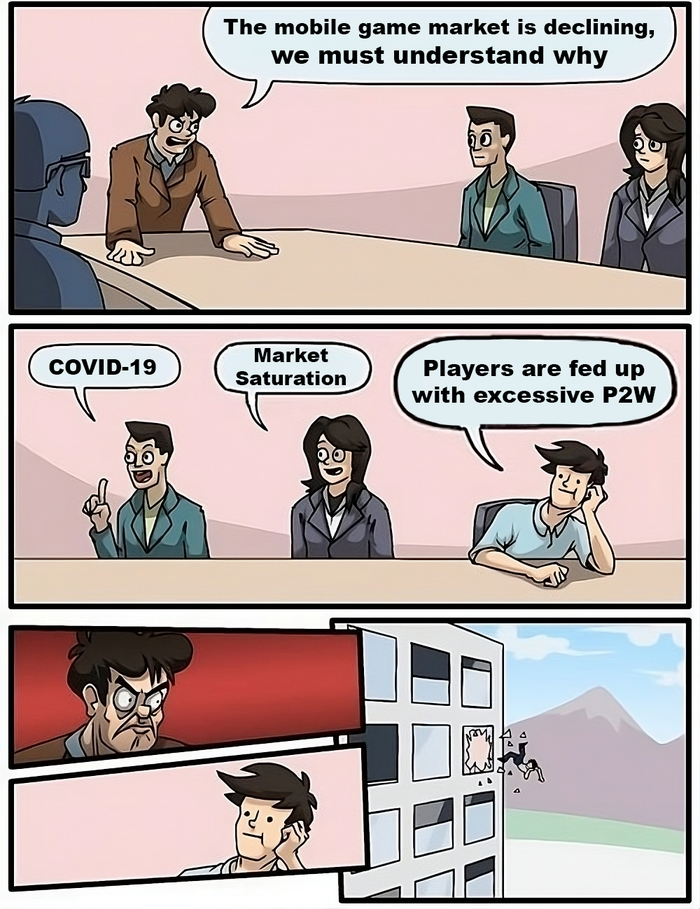
Instead, purchasable items should be bonuses, and, more importantly, players should be able to finish the game without needing to pay. This makes in-game purchases a luxury, not a requirement. After all, players should pay not because they’re forced to, but because they want to support the game and enjoy additional content.
In the end, remember that excessive focus on monetization can make you forget the main purpose of creating games. Why are we in this business? First and foremost, to provide an exceptional experience for players.
Major game studios, which once produced fantastic games remembered by players decades later, sometimes devolve into bureaucracy and business, forgetting their original purpose. They turn games into lifeless, dull copies of the original. You download such a game—the graphics are beautiful, there are no bugs, and the story progresses along familiar lines, but something feels off. You may not realize it right away, but subconsciously, you sense: the game has no soul. It’s just another product on the conveyor belt, created to maximize profits but not to give players a truly engaging and memorable experience. The goal is to create something that touches players, that they’ll discuss with friends and want to relive.
"It’s not just about ‘games,’ for me, personally, it never has been. It’s about creating something—something much larger than yourself."
Shigeru Miyamoto
The idea of a living economy in games is that it can’t be imposed. As a developer, you might say, “We don’t care, we’re just making a fantasy game.” But the problem is, with a well-built and lively game economy, the game feels much deeper to the community.
When we talk about monetization, economics, and balance, it’s important to remember that behind every chart and every entry in analytics lies a real person choosing to give you not only their money but their most precious asset—their time.
By creating a game, you are essentially offering people a piece of your soul. Your job is to make that fragment bring joy to players and enable you to keep creating. And let’s not forget: the world of games is vast and diverse, and your unique perspective makes it even more fascinating.
Do you think your work is done? Far from it. Game worlds live on their own. Players will continue to discover new facets of what you’ve created. They’ll debate, share experiences, and return time and again. And you? You’ll simply smile, watching as your creation comes alive for millions and brings you a stable income.
Thank you for journeying down this long road with me. I hope your future games will bring not only profit but joy to millions of players. You’re giving them moments that will stay with them for years. And that’s worth far more than any amount of money.
[1] Newzoo.com (2024). Games market trends to watch in 2024. [online] Available at: https://newzoo.com/resources/trend-reports/games-market-trends-to-watch-in-2024.
[2] GamesIndustry.biz. (2020). The Core Principles of Building Prosperous Game Economies. [online] Available at: https://www.gamesindustry.biz/the-core-principles-of-building-prosperous-game-economies.
[3] Udonis Blog. (2023). How to Create a Balanced Mobile Game Economy. [online] Available at: https://www.blog.udonis.co/mobile-marketing/mobile-games/balanced-mobile-game-economy.
[4] Dardis, F., Schmierbach, M., & Limperos, A. (2019). Game difficulty and framing influence memory for in-game advertisements. Journal of Consumer Marketing, 36(1), 37-48. Available at: https://www.emerald.com/insight/content/doi/10.1108/JCM-07-2016-1878/full/html.
[5] Lee, J., & Shin, D. (2017). The side effects of in-app reward advertising: An investigation into the negative consequences of rewarded ads. Journal of Advertising Research, 57(3), 272-286. Available at: https://www.journalofadvertisingresearch.com/content/57/3/272.
[6] Jiao, Y., Li, L., & Luo, X. (2022). A study of play duration and purchase behavior in mobile games. Production and Operations Management, 31(1), 139-157. Available at: https://journals.sagepub.com/doi/10.1111/poms.13772.
[7] Game Developer. (n.d.). 5 Basic Steps in Creating Balanced In-Game Economy. [online] Available at: https://www.gamedeveloper.com/design/5-basic-steps-in-creating-balanced-in-game-economy
[8] Game Developer. (n.d.). My Approach To Economy Balancing Using Spreadsheets. [online] Available at: https://www.gamedeveloper.com/design/my-approach-to-economy-balancing-using-spreadsheets
[9] Karpenko. A. (2022). How is balance created. [online] Available at: https://docs.google.com/document/d/1fp5J83GKCdFgvt6F-bI-qz44OKT6x2RECnLIokmEuUc/edit
[10] Schreiber I., Romero B. Game Balance, 1st ed.– Boca Raton: CRC Press.– 2021.– ISBN 978-1498799577.– 806 pp.
[11] Rouse R. Game Design: Theory and Practice, Wordware Game Developer’s Library, 2nd ed.– Jones & Bartlett Learning.– 2004.– ISBN 978-1556229121.– 704 pp.
[12] Wang W., Zhang R. Improved game units balancing in game design through combinatorial optimization, 2021 IEEE International Conference on e-Business Engineering (ICEBE) (12–14 November 2021, Guangzhou, China).– 2021.– pp. 64–69. https://doi.org/10.1109/ICEBE52470.2021.00022
[13] Novak J. Game Development Essentials: An Introduction, 3rd ed.– Melbourne: Cengage Learning.– 2011.– ISBN 978-1111307653.– 510 pp.
[14] Rollings A., Adams E. Andrew Rollings and Ernest Adams on Game Design, 1st ed.– Indianapolis: New Riders Publishing.– 2003.– ISBN 978-1592730018.– 400 pp.
[15] Fang, J. (2019). In-Game Currency Design and Consumer Spending Behavior. Michigan Ross Senior Thesis Seminar. Available at: https://deepblue.lib.umich.edu/bitstream/handle/2027.42/155343/Justin?sequence=1
[16] Grguric, Mihovil. "Top Mobile Game Monetization Strategies for 2024." Udonis, July 2, 2024. https://www.blog.udonis.co/mobile-marketing/mobile-games/mobile-game-monetization
[17] Doroshenko A., Zubov A., "Casual Gaming In H1’24: Tough Competition And New Opportunities", Aug 20, 2024. Available at: https://appmagic.rocks/research/casual-gaming-2024-h1
[18] GamesIndustry.biz. "What's next for in-app purchases, in-game ads and mobile monetization." July 2024, Available at: https://www.gamesindustry.biz/whats-next-for-in-app-purchases-in-game-ads-and-mobile-monetization
[19] Sensor Tower Blog. "2024 State of Mobile.", Sensor Tower Blog, June 2024., Available at: https://sensortower.com/blog/state-of-mobile-2024
[20] Khripin M., "Best practices for in-game shops." Balancy, July 23, 2024. https://balancy.co/blog/2024/07/23/new-book-best-practices-for-in-game-shops/
[21] Zhang, Y., Li, X., & Wang, J. (2023). Rethinking Customer Lifetime Value Modelling: Identification of Whales in Games. Available at: https://dl.acm.org/doi/10.1145/3583780.3615002
[22] Grguric, M. (2024). How to Create a Balanced Mobile Game Economy. Udonis Blog. Available at: https://www.blog.udonis.co/mobile-marketing/mobile-games/balanced-mobile-game-economy.
[23] Jayemanne, D., Chillas, S., Moir, J., Rocha, A., Fraser, S. & Wardle, H. 2021. Loot Boxes and Digital Gaming: A Rapid Evidence Assessment. London, Department for Culture, Media and Sport
[24] Karpenko. A. (2024). The Perfect Simulation: How Chaos Makes the World Interesting. Medium. Available at: https://medium.com/@wiserax2037/the-perfect-simulation-how-chaos-makes-the-world-interesting-54d196be0e36
You May Also Like